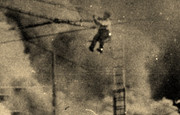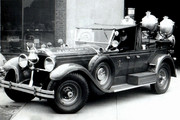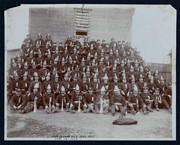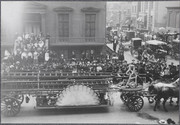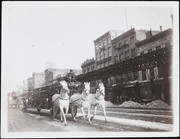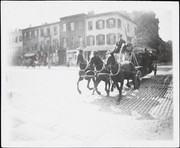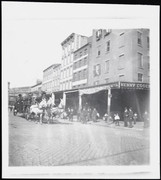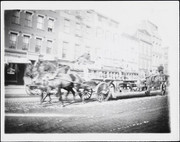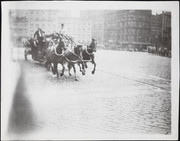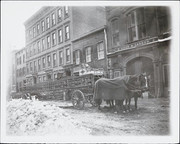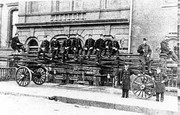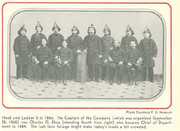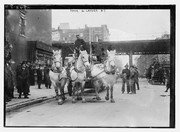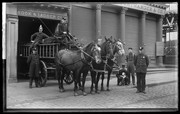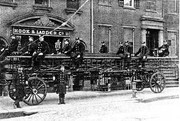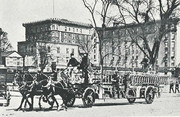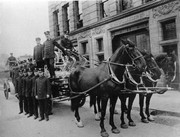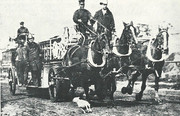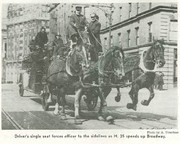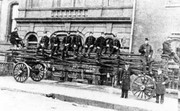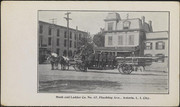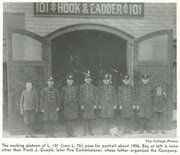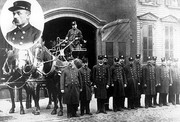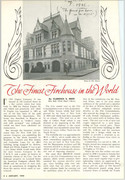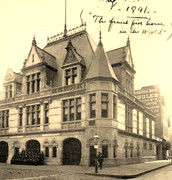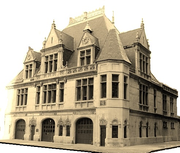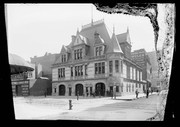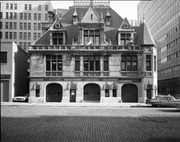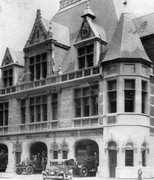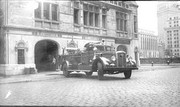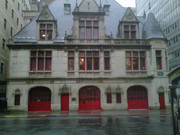You are using an out of date browser. It may not display this or other websites correctly.
You should upgrade or use an alternative browser.
You should upgrade or use an alternative browser.
FDNY and NYC Firehouses and Fire Companies - 2nd Section
- Thread starter mack
- Start date
- Joined
- Sep 25, 2013
- Messages
- 1,000
Long Island City Ladder 1 initially became Ladder 15 FDNY for approximately 6 months in 1899, before being renumbered as Ladder 65 later in 1899, and then being renumbered as Ladder 115 in 1913.mack said:Ladder 1 LICFD organized 12-16 47th Road former volunteer firehouse 1891
Ladder 1 LICFD became Ladder 1 FDNY 1898
Ladder 1 became Ladder 65 1899
Ladder 65 new firehouse 10-42 47th Avenue w/Engine 158 1904
Ladder 65 became Ladder 115 1913
Ladder 115 moved 11-15 37th Avenue at Engine 260 1999
Ladder 115 returned 10-40 47th Avenue w/Engine 258 2000
- Joined
- May 6, 2010
- Messages
- 17,483
In mack's reply # 258 above mention is made of a "Relay Hose Wagon"... ("Relay Hose Wagon 4 Queens organized 10-40 47th Avenue at Ladder 115 in 1942 & Relay Hose Wagon 4 Queens disbanded in 1945") ..... during WW2 Relay Hose Wagons were organized & equipped to carry large amounts of Hose in case water mains here in NYC were bombed ....i don't know about this particular Rig # 4 but i have seen a picture of one (#?) that was built on a Hook & Ladder chassis complete with a Tillerman....maybe someone can dig up a picture of one of these interesting Rigs......( not sure but i think i remember it being painted gray or white in the picture ?).
- Joined
- Sep 25, 2013
- Messages
- 1,000
mack said:Battalion 15 organized 12-17 Jackson Avenue at Engine 1 1898
Battalion 15 became Battalion 35 1898
Battalion 35 new firehouse 10-40 47th Avenue w/Engine 158 1904
Battalion 35 disbanded (reorganized in Brooklyn at Engine 111) 1906
Battalion 45 organized 10-40 47th Avenue at Engine 158 1906
Battalion 45 moved 33-51 Greenpoint Avenue at Engine 259 1979
Long Island City FD Battalion 1 became Battalion 15 FDNY in 1898, then was renumbered as Battalion 35 later in 1898, then renumbered as Battalion 45 in 1906.
Brooklyn FD District Engineer 5 became Battalion 25 FDNY in 1898, then was renumbered as Battalion 35 in 1906.
Both the Brooklyn and the Long Island City battalions pre existed the merger with FDNY, thus Queens BC35 gave up their number to become BC45, while Brooklyn BC25 gave up their number to become BC35, and BC25 was used again in Manhattan in 1907.
Queens and Brooklyn both had a BC35, but their timelines are simultaneous and separate.
68jk09 said:In mack's reply # 258 above mention is made of a "Relay Hose Wagon"... ("Relay Hose Wagon 4 Queens organized 10-40 47th Avenue at Ladder 115 in 1942 & Relay Hose Wagon 4 Queens disbanded in 1945") ..... during WW2 Relay Hose Wagons were organized & equipped to carry large amounts of Hose in case water mains here in NYC were bombed ....i don't know about this particular Rig # 4 but i have seen a picture of one (#?) that was built on a Hook & Ladder chassis complete with a Tillerman....maybe someone can dig up a picture of one of these interesting Rigs......( not sure but i think i remember it being painted gray or white in the picture ?).
Thanks Chief. Rigs were painted gray and had blacked out headlights.

FDNY "24 hours in the FDNY firehouse that never sleeps"
By NJ Burkett with exclusive access at one of New York City's busiest fire houses.
Monday, February 12, 2018 FLATBUSH, Brooklyn (WABC) --
http://abc7ny.com/24-hours-in-the-firehouse-that-never-sleeps/3072654/
"It's long past midnight in Flatbush, Brooklyn, and firefighter Mark Merrell of Engine 255 is explaining to me why medals aren't important and being called a hero doesn't matter all that much.
"What you try to achieve is for somebody to say, 'you're a good fireman.' That's probably the biggest compliment you can get," he says. "And that don't come easy."
The firehouse kitchen erupts in laughter. Mark smiles, because it's a tough crowd and he knows I know that. But I'm spending twenty-four hours with the firefighters of Engine Company 255 and Ladder Company 157 -- one of the busiest firehouses in New York - and I'm ready for pretty much anything.
The FDNY granted us total access and even provided a chase car with lights, siren and a driver.
Eyewitness News photographer Josh Hartmann and I followed them on virtually every run. There was just one restriction: Don't show the cooking. Why? "It's corny," they told me. (But the chicken marsala was excellent, I have to say.)
No, we didn't sleep at all. It's hard to do that when the alarms go off all night. And we learned pretty quickly that if you're not out the door in 52 seconds, tower ladder chauffeur Dean Montesani will leave you in the dust.
I don't think we ever had more than two hours between runs, and it was often much less than that. I've covered just about every major fire in New York City since Happy Land, and I was amazed at how much I had yet to learn.
Did you know the turnout gear can weigh as much as 100 pounds? (Which amounts to about two-thirds of my body weight.) And it's not like in the movies--when you're running into a fire you often can't see anything. You're groping your way through the smoke to find the fire and any victims who may have been unconscious or trapped.
These firefighters were among the first on the scene in Midwood in March of 2015, when seven children died in a raging house fire.
Pat Rooney of Ladder 157 stood at the scene with me, and tried to put it into words.
"The whole first floor was on fire," he told me. "To be honest, you get reports of people trapped all the time, and they're not there. One neighbor is like, 'There's seven kids in there.' And no way there's seven kids there. I put my ladder up to the bedroom window and went in and there's a kid laying on the floor. You don't think there's gonna be anybody, so when you find one it's a surprise. And when you find out there were seven, it's brutal. I thought about this fire for over a year. Every day, every single day."
"When it's successful," Mark Merrell told me, "there's nothing better. When it's tragedy, you have to deal with it and move on."
That's hard, of course, and they don't really like to talk about it.
Sitting around the kitchen, camera rolling, I ask a serious question. "What's the hardest part of this job?" The answer, almost in unison, "When a reporter wants to hang out in the firehouse." More laughter. Yes, it's a tough crowd.
But you won't find a more upbeat, dedicated group of firefighters anywhere in America. I hope they'll invite me back for dinner some night soon."
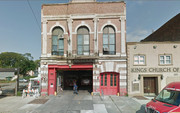

By NJ Burkett with exclusive access at one of New York City's busiest fire houses.
Monday, February 12, 2018 FLATBUSH, Brooklyn (WABC) --
http://abc7ny.com/24-hours-in-the-firehouse-that-never-sleeps/3072654/
"It's long past midnight in Flatbush, Brooklyn, and firefighter Mark Merrell of Engine 255 is explaining to me why medals aren't important and being called a hero doesn't matter all that much.
"What you try to achieve is for somebody to say, 'you're a good fireman.' That's probably the biggest compliment you can get," he says. "And that don't come easy."
The firehouse kitchen erupts in laughter. Mark smiles, because it's a tough crowd and he knows I know that. But I'm spending twenty-four hours with the firefighters of Engine Company 255 and Ladder Company 157 -- one of the busiest firehouses in New York - and I'm ready for pretty much anything.
The FDNY granted us total access and even provided a chase car with lights, siren and a driver.
Eyewitness News photographer Josh Hartmann and I followed them on virtually every run. There was just one restriction: Don't show the cooking. Why? "It's corny," they told me. (But the chicken marsala was excellent, I have to say.)
No, we didn't sleep at all. It's hard to do that when the alarms go off all night. And we learned pretty quickly that if you're not out the door in 52 seconds, tower ladder chauffeur Dean Montesani will leave you in the dust.
I don't think we ever had more than two hours between runs, and it was often much less than that. I've covered just about every major fire in New York City since Happy Land, and I was amazed at how much I had yet to learn.
Did you know the turnout gear can weigh as much as 100 pounds? (Which amounts to about two-thirds of my body weight.) And it's not like in the movies--when you're running into a fire you often can't see anything. You're groping your way through the smoke to find the fire and any victims who may have been unconscious or trapped.
These firefighters were among the first on the scene in Midwood in March of 2015, when seven children died in a raging house fire.
Pat Rooney of Ladder 157 stood at the scene with me, and tried to put it into words.
"The whole first floor was on fire," he told me. "To be honest, you get reports of people trapped all the time, and they're not there. One neighbor is like, 'There's seven kids in there.' And no way there's seven kids there. I put my ladder up to the bedroom window and went in and there's a kid laying on the floor. You don't think there's gonna be anybody, so when you find one it's a surprise. And when you find out there were seven, it's brutal. I thought about this fire for over a year. Every day, every single day."
"When it's successful," Mark Merrell told me, "there's nothing better. When it's tragedy, you have to deal with it and move on."
That's hard, of course, and they don't really like to talk about it.
Sitting around the kitchen, camera rolling, I ask a serious question. "What's the hardest part of this job?" The answer, almost in unison, "When a reporter wants to hang out in the firehouse." More laughter. Yes, it's a tough crowd.
But you won't find a more upbeat, dedicated group of firefighters anywhere in America. I hope they'll invite me back for dinner some night soon."


Engine 255/Ladder 157 firehouse 1367 Rogers Avenue Flatbush, Brooklyn 15th Division, 41st Battalion "The Jolly Rogers"
Engine 55 BFD organized 1367 Rogers Avenue w/Ladder 25 BFD 1897
Engine 55 BFD became Engine 55 FDNY 1898
Engine 55 became Combination Engine Company 55 1898
CEC 55 became CEC 155 1899
CEC 155 became CEC 255 1913
CEC 255 became Engine 255 1927
Ladder 25 BFD organized 1367 Rogers Avenue w/Engine 55 BFD 1897
Ladder 25 BFD became Ladder 25 FDNY 1898
Ladder 25 disbanded (Engine 55 became CEC 55) 1899
Ladder 157 organized 1367 Rogers Avenue at Engine 255 1927
1367 Rogers Avenue 1897:
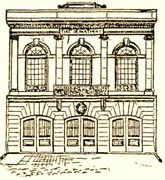
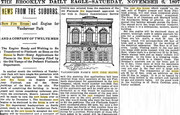
1367 Rogers Avenue 1940s:

1367 Rogers Avenue 1980s:
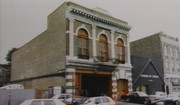
1367 Rogers Avenue:
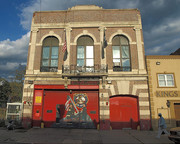
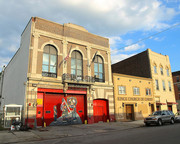

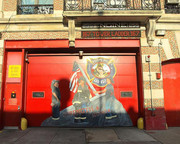
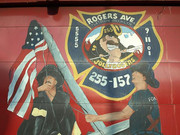
Engine 255/Ladder 157:

Engine 255:
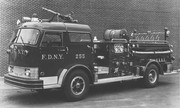
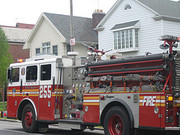


Ladder 157:


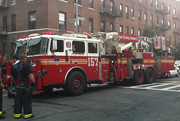
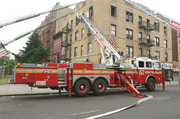
Engine 255/Ladder 157:
https://www.youtube.com/watch?v=ntk14Gsu8AA
https://www.youtube.com/watch?v=Hn8GpDmSOgM
https://www.youtube.com/watch?v=bWKZxpuVSAw
Engine 255/Ladder 157 100 years:
http://nyfd.com/brooklyn_engines/engine_255/engine_255_history.html
Flatbush Fire Department volunteer companies:
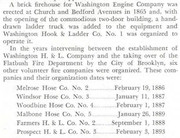
Engine 255/Ladder 157 Medals:
CAPT. JOHN T. ROKEE DEC. 16, 1962 1963 PRENTICE ASSIGNED TO DIV. 12 AND DETAILED TO LAD. 157
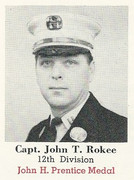
Captain John T. Rokee, Covering in Ladder 157, 12th Division, received the John H. Prentice Medal for assisting in rescuing the trapped occupants of 1391 Flatbush Avenue on December 16, 1962. Captain Rokee helped the remaining people that Fireman Fraker had brought down out of the hallway. He then went upstairs to the 2nd and 3rd floor and found another group of people trapped, and brought them down to safety. Between Fireman Fraker and Captain Rokee they rescued six adults and eight children.
FF. LAWRENCE J. FRAKER DEC. 16, 1962 1963 BROOKLYN CITIZENS
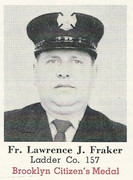
Fireman 1st grade Lawrence J. Fraker Ladder 157, received the Brooklyn Citizens Medal for rescuing the occupants of 1391 Flatbush Avenue on December 16, 1962. Fireman Fraker found twelve occupants on the 2nd floor landing refusing to move due to the heat coming up the stairwell. Pushing, carrying, he forced them down the stairs only to be blocked by fire coming from the store on the first floor. He placed himself between the fire and their escape and six managed to get out before his clothing caught fire. Seeing this, the members of Engine 255 put a charged hose line on Fireman Fraker. Before being taken to the hospital he notified his officer that there were more people trapped in the hallway
FF. ROBERT L. TYRRELL APR. 24, 1968 1969 HISPANIC
Fireman 1st grade Robert L. Tyrrell Ladder 157, received the Hispanic Society Memorial Medal for rescuing a woman and child from a third floor bedroom at 1094 New York Avenue on April 24, 1968. He made a search of the fire apartment and found Barbara Beckwick unconscious. He dragged the unconscious form to the window and handed the woman to other members of Ladder 157, Going back into the burning bedroom he found Dawn Grier, 10 months old in a burning crib. Scooping up the child he raced to the front door as other members of Ladder 157 were breaking down the door. He handed the child to Lieutenant Spitz before collapsing and had to be carried out of the building himself. Mrs. Beckwick was placed on the critical list but, the child died in the hospital. All this was done before any water was placed on the fire.
FF. ROBERT L. TYRRELL APR. 24, 1971 1972 CONRAN
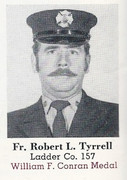
Firefighter 1st grade Robert L. Tyrrell Ladder 157, received his second medal, the William F. Conran Medal for rescuing two children from a bedroom at 2525 Bedford Avenue on April 24, 1971. He entered the fire floor via the rear fire escape and found one child just inside the bedroom window. He handed the child to waiting members outside of the window and entered the room for a second search. Fireman Tyrrell was taking a terrible beating from the heat and smoke but found the second child between the bed and wall. He carried this child to the window and safety. He then entered a third time to search a crib in the bedroom but found no additional children. After the third search Fireman Tyrrell had to be assisted out of the fire building because of exhaustion. Both children recovered in the hospital.
FF. ROBERT A. BRILL FEB. 25, 1975 1976 PULASKI

Fireman 1st Grade Robert A. Brill Ladder 157, received the Pulaski Association Medal for rescuing a little girl from a smoke filled room at 2323 Newkirk Avenue on February 25, 1975. Fireman Brill entered the window of a first floor apartment upon hearing that a child was trapped in the building. The fire had taken possession of three rooms on the fire floor. He worked his way toward the rear bedrooms looking for this child. In the last room he found the girl, unconscious. He protected the little girl with his coat and found his way back to the window, giving the little girl new lease on life. All this was done without the use of a mask or a charged hose line.
FF. ROBERT L. TYRRELL MAR. 12, 1976 1977 LANE
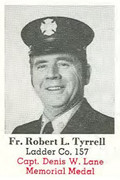
Fireman 1st grade Robert L. Tyrrell Ladder 157, received the Captain Denis W. Lane Memorial Medal for rescuing two people from a third floor apartment at 800 E. 14th Street on March 12, 1976. Firemen Tyrrell drove the company?s tower ladder to the front of the building. As he was raising th bucket it stopped and froze in place and would not budge. He then went for a 35? ladder and placed it at the third floor window. The flames were pushing out of the first and second floor windows as Fireman Tyrrell went up the ladder to rescue a man from the third floor. Shielding the man from the flames he brought him down to safety. The man said that a bedridden woman was still on the third floor. Going back up the ladder and passing the flames Fireman Tyrrell found the 78 year old woman and dragged her to the window. During this time the tower ladder had been fixed and moved to the window. Both Tyrrell and the woman enter the safety of the bucket.
FF. LAWRENCE MURPHY SEP. 12, 1981 1982 DOLNEY
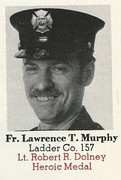
Fireman 1st Grade Lawrence T. Murphy Ladder 157, received the Lt. Robert R. Dolney Medal for rescuing a woman from a burning apartment at 596 Argyle Road on September 12, 1981. Fireman Murphy entered the fire apartment on his hands and knees. Beside pushing through the heat of the fire Murphy had to fight his way through a "Collier mansion." He had to climb over, around and under the junk that blocked his way. He found Ermine Harkins collapsed behind the bathroom door, blocking it from opening. Murphy forced the door open and dragged the unconscious woman to a safe place. She was not breathing and burned over 20 percent of her body. Fireman Murphy along with other firemen brought her back to life. She recovered fully after a long hospital stay.
CAPT. STANLEY FONER, JAN. 8, 1984 1985 UFOA
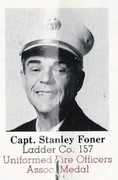
Captain Stanley Foner Ladder 157, received the Uniformed Fire Officers Association Medal for rescuing a woman from 1921 Avenue "I" on January 8, 1984. Upon arriving at the fire building tenants told the Captain that a woman was trapped in the building. Captain Foner forced the door of the fire apartment and made a search while other members of Ladder 157 donned their mask. He entered the apartment and started his search only to be forced back by the heat. Hearing the woman was still missing, he entered the apartment once again and this time went deeper into the burning apartment. In the rear bedroom he found the woman unconscious and covered with a blanket. Completely covering her with the blanket he dragged her through two rooms of fire to the public hallway. Ann Feslowick survived the fire due to the determination of Captain Foner.
FF. HARVEY L. HARRELL MAR. 12, 1986 1987 THIRD ALARM
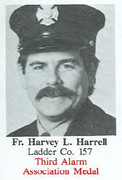
Fireman 1st grade Harvey L. Harrell Ladder 157, received the Third Alarm Association Medal for rescuing a man from a fire at 1400 E. 52nd Street on March 12, 1986. Fireman Harrell performed his duty as the outside ventilation man, then went to the rear of the fire building to survey conditions. He forced entry through the rear door into the kitchen and began his search with the living room being fully involved in fire. Entering the bedroom Harvey located a lifeless form partially under the bed. Knowing he could not return through the kitchen because of the fire he tried to get out a window only to be trapped by window bars. Knowing he had only a short time before the room flashed over he retraced his steps back through the kitchen. He dragged the victim under the roaring fire overhead to the outside. The 72 year old man had been burned so severely that he died several hours later.
FF. GARETH S. NIESEN APR. 5, 1991 1992 THOMPSON
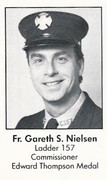
Fireman 1st grade Gareth S. Nielsen Ladder 157, received the Commissioner Edward Thompson Medal for rescuing a woman from a burning second floor apartment in a private dwelling at 2421 Avenue "L" on April 5, 1991. Fireman Nielsen was told that people were trapped in the fire apartment. As he was placing a ladder in the rear a woman appeared on the porch yelling her mother was in the fire apartment. Notifying the chief that he was going into the apartment to rescue the woman. He went through the window and started his search. Halfway through he heard a moan to his left and went toward the sound giving up the safety of the wall. With the heat building up in the room and a flashover happening at any moment he found Rosalie Steiner, 80 years old in the hallway and bedroom. Kneeling he dragged, and half carried her to the bedroom window where he lifted her out and on to the porch. She was burnt over forty percent of her body but did surveyed.
LT. JEREMIAH P. COLLINS SEP. 25, 1991 1992 FIRE CHIEFS
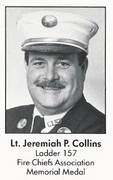
Lieutenant Jeremiah P. Collins Ladder 157, received the Fire Chiefs Association Memorial Medal for attempting the rescuing of a man in a basement bedroom at 625 Westminster Road on September 25, 1991. Lt. Collins going down the basement stairs yelled out "Is anyone down here?" and heard someone say "Help me." Going deeper into the basement he found Bruce Donelon in the fire room. Crawling under the fire he tried to pull the 300 pound man out. Another firefighter joined in trying to get the man out. The room suddenly burst into flames and the three men were taking a terrible beating. The protective fire gear protected the two firemen somewhat but all three were burning. Just in time the engine put water on the fire and the three were pulled out. Unfortunately the heat and fire were to much for the 35 year old man and he died in the hospital.
FF. DANIEL J. DEMPSEY APR. 16, 1992 1993 BROOKLYN CITIZENS
Fireman 1st grade Daniel J. Dempsey Ladder 157, received the Brooklyn Citizens Medal for rescuing a 4 year old child from 799 E. 8th Street on April 16, 1992. Ladder 157 arrived in front of a three story wood frame house with heavy black smoke pushing from the second floor windows and cockloft. The first due engine transmitted a 10-70, a delay in getting water on the fire. Fireman Dempsey was told that children were trapped on the fire floor. Without hesitation he placed a portable ladder to the second floor and entered the smoke filled hallway. He crawled on his belly to the front bedroom and found the door locked. Breaking the door down he located the limp form of young Yisroel Frank. Not breathing Fireman Dempsey took off his mask and placed it on the young child. Crawling back into the hallway he dragged the young child to the stairs and down to safety.
LT. ROBERT BOLKER OCT. 24, 1992 1993 MC ELLIGOTT
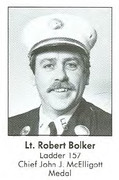
Lieutenant Robert Bolker Ladder 157, received the Chief John J. McElligott Medal for the attempted rescue of a little girl from a fire at 179 Linden Boulevard on October 24, 1992. Ladder 157 arrived first at six story apartment building with smoke pushing out the first floor apartment windows. A mother was screaming that her child was in the rear bedroom. Lieutenant Bolker did not hesitate, pass the fire in the living room knowing the hydrant was not working. Once in the bedroom he started his search and found little 2 year old Itye Whyte wedged between the wall and the bed. Protecting the child as best as he could, he crawled down the hall, passing the fire in the living room that was growing. Once outside Lieutenant Bolker started CPR on the little girl until relieved by Engine 249. Despite the heroic effort made by the members of Ladder 157, the child received burns over 50% of her body and died in the hospital.
LT. JOHN J. PRITCHARD MAR. 27, 1992 1993 LA GUARDIA
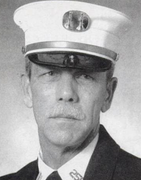
Lieutenant John J. Pritchard Ladder 157, received the Mayor LaGuardia Medal for the attempted rescue of a 70 year old man at 1188 E. 34th Street on March 27, 1992. Ladder 157 arrived several minutes after Engine 255 arrival and were told that a man was trapped in the fire. Lieutenant James Greco, was being carried out after trying to rescue the trapped man. Lieutenant Pritchard entered the fire building and encountered heavy smoke and high heat. He stay low as he made his way to the bedroom, which was burning along with the living room. Once in the living room Lieutenant Pritchard found Joseph O?Leary on the bed with his clothing on fire. He pulled him from the bed, extinguished the burning clothes. The fire intensified as he was dragging the victim to safety. All during this time Lieutenant Pritchard was receiving serious burns to his neck and face. Mr. O?Leary was removed to Coney Island Hospital and succumbed to his injuries. Lieutenant Pritchard spent over two months on medical leave recovering from his burns.
LT. JAMES M. AMATO JAN. 29, 1993 1994 FIRE BELL CLUB ASSIGNED TO B-58 AND DETAILED TO LAD. 157
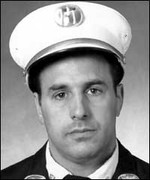
Lieutenant James M. Amato, assigned to Battalion 58 and covering in Ladder 157, received the Fire Bell Club Medal for rescuing Maryann Shapiro, age 90 years old, from 5455 Kings Highway on January 29, 1993. Ladder 157 was assigned as an additional truck to the box. Information was relayed to Lieutenant Amato that a woman was trapped on the fourth floor. Lieutenant Amato and his forcible entry team went to the fire floor and saw two apartments on fire. The doors to the two apartment were left open and a 45 mile per hour wind was blowing the fire out the doors like a blow torch. Lieutenant Amato crawled down the hallway passed the fire to apartment 4J where the woman was found semi-conscious. Two engine companies had entered the hallway and drove the fire back into the two apartments and Lieutenant Amato removed the victim down the interior stairway. The fire would burn out that floor and two other floors. If it wasn?t for Lieutenant Amato bravery Maryann Shapiro would have perished in the fire.
Captain James M. Amato, LODD, September 11, 2001, Squad 1
FF. THOMAS J. GARDNER NOV. 7, 1993 1994 GOLDMAN
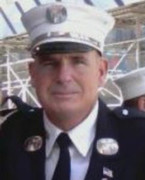
Fireman 1st grade Thomas J. Gardner Ladder 157, received the Edith B. Goldman Medal for rescuing a woman from a basement apartment at 729 E. 26th Street on November 7, 1993. When Ladder 157 arrived people were screaming that a woman was trapped in the basement apartment. Part of the forcible entry team, Tom entered the hallway that leads to the basement and 1st floor. The door blocked the basement stairs and prevented the placement of a hoseline into the basement. Knowing this Tom went down into the basement to look for the woman. The fire was in the small kitchen across the room. Because of the limited ventilation and low ceilings the heat was building up and conditions were becoming unbearable. Continuing passed the kitchen on his belly he found the bedroom and entered it looking for the victim. He found 45 year old Jacqueline Vital, unconscious on the bed. He dragged her through the bedroom and kitchen, up the stairs and to safety. She was admitted to the hospital and would recover.
FF. THOMAS E. CLAIR III OCT. 14, 1994 1995 THIRD ALARM
Fireman 1st grade Thomas E. Clair III, received the Third Alarm Association Medal for rescuing a 35 year old man from 734 E. 8th Street on October 13, 1994. While enroute the company was given reports that people were trapped in the building. Smelling the fire several blocks away, Ladder 157 could not believe what they saw when pulling up in front of the fire building. A two story wood frame private dwelling that had fire coming out every window on both floors. With little time left the forcible entry team went up the partially burnt staircase to the second floor. The fire had total control of the rear bedrooms moving down the hallway to the front bedrooms. Tom raced the fire to one of the front bedroom and started his search. He located a mattress on the floor and found Eric Penzola not responding lying on it. Knowing he could not retreat back through the hallway because of the advancing fire Tom called for a ladder to carry what seemed at the time a dead man. Before a ladder could be placed against the window an engine company was putting water on the fire in the hallway. Without a second thought Tom carried the man down the hallway and down the stairs to safety. Eric would spend a long time in the hospital before recovering and getting on with his life.
LT. ROBERT J. BOLKER DEC. 13, 1994 1995 DOUGHERTY


Lieutenant Robert J. Bolker Ladder 157, received the Thomas F. Dougherty Medal for rescuing five people from a fire at 371 E. 32nd Street on December 13, 1994. Lt. Bolker received over the radio that people were trapped in the fire building. Racing in with the forcible entry team they found the fire was in the basement even though the smoke only coming out of the second floor windows. The roofman radioed that he could see some people in the rear top bedroom. Lt. Bloker worked his way to the rear bedroom were he found a 3 month boy and a 13 day old boy along with three women in their thirty?s. One by one the five victims were handed out to the members of Ladder 147. All five were overcome by smoke and after a short stay in the hospital all recovered.
FF. ANTHONY ROCCO, JR. OCT. 8, 1990 1991 LAUFER

Fireman Anthony Rocco, Jr. Engine 255 detailed to Ladder 157, received the Arthur J. Laufer Memorial Medal for rescuing an 88 year old lady from a fire at 1006 E. 36th Street on October 8, 1990. The first run of the night found the company responding to a report of fire in a second floor apartment. Once on the scene it was learnd that two elderly sisters were still in the fire apartment. Anthony being the can man went to the fire apartment and used his extinguisher to keep the flames in check inside the fire apartment. He entered the apartment to look for the two ladies only to be blocked by their collection of newspapers and other treasures that the ladies collected. Once through the obstacle course he located 88 year old Mary Greenhill, unconscious in the rear bedroom. Anthony could see Engine 255 in position with the hose line to attack the fire when they backed out without putting water on the fire due to a burst hose line. Knowing he did not have much time left he looked for another way out and could not find one so he closed the bedroom door to buy some extra time. Only when he heard water hitting the fire did he open the door and carry the woman out of the building and to safety.
FF. DOMINICK M. MUSCHELLO, NOVEMBER 19, 2014, BROOKLYN BOX 22-2446, BKLYN CITIZENS/FF LOUIS VALENTINO AWARD
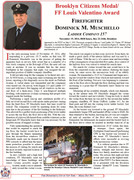
FF. MICHAEL RYSETNYK, DECEMBEL 11, 2015, BROOKLYN BOX 75-2441, BKLYN CITIZENS/FF LOUIS VALENTINO AWARD
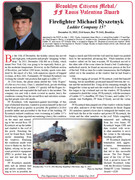
Ladder 157 LODD:
FF Thomas F Shortell, US Marine Corps KIA, Iwo Jima, March 8, 1945
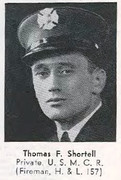
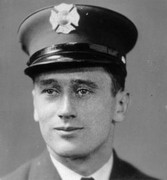
Thomas Francis Shortell (known to friends and family as Tommy or Tom), was the son of a New York City Firefighter. He was born in Brooklyn, New York in 1914. He was appointed to the Fire Department of New York City on June 6, 1938 and was assigned to Engine 316. On January 1st 1941 he was transferred to Ladder Company 157, where he worked until his enlistment in U.S. Marine Corps on June 27th 1944. Tom served with the 3rd Marine Division in the South Pacific. He made the ultimate sacrifice for his country when he was killed on Iwo Jima on March 8th 1945. He was survived by his mother, Helen O'Mara Shortell, his brother John (Jack) Shortell, and four children: Thomas (Tom), Carol, Gerard (Jerry) and Hellen.
Flatbush:
http://www.brooklynhistory.org/exhibitions/lefferts/historic-flatbush-maps/
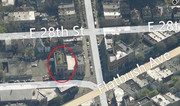

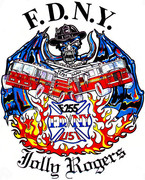
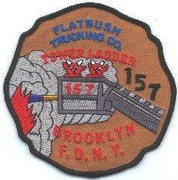
Engine 55 BFD organized 1367 Rogers Avenue w/Ladder 25 BFD 1897
Engine 55 BFD became Engine 55 FDNY 1898
Engine 55 became Combination Engine Company 55 1898
CEC 55 became CEC 155 1899
CEC 155 became CEC 255 1913
CEC 255 became Engine 255 1927
Ladder 25 BFD organized 1367 Rogers Avenue w/Engine 55 BFD 1897
Ladder 25 BFD became Ladder 25 FDNY 1898
Ladder 25 disbanded (Engine 55 became CEC 55) 1899
Ladder 157 organized 1367 Rogers Avenue at Engine 255 1927
1367 Rogers Avenue 1897:


1367 Rogers Avenue 1940s:

1367 Rogers Avenue 1980s:

1367 Rogers Avenue:





Engine 255/Ladder 157:

Engine 255:




Ladder 157:




Engine 255/Ladder 157:
https://www.youtube.com/watch?v=ntk14Gsu8AA
https://www.youtube.com/watch?v=Hn8GpDmSOgM
https://www.youtube.com/watch?v=bWKZxpuVSAw
Engine 255/Ladder 157 100 years:
http://nyfd.com/brooklyn_engines/engine_255/engine_255_history.html
Flatbush Fire Department volunteer companies:

Engine 255/Ladder 157 Medals:
CAPT. JOHN T. ROKEE DEC. 16, 1962 1963 PRENTICE ASSIGNED TO DIV. 12 AND DETAILED TO LAD. 157

Captain John T. Rokee, Covering in Ladder 157, 12th Division, received the John H. Prentice Medal for assisting in rescuing the trapped occupants of 1391 Flatbush Avenue on December 16, 1962. Captain Rokee helped the remaining people that Fireman Fraker had brought down out of the hallway. He then went upstairs to the 2nd and 3rd floor and found another group of people trapped, and brought them down to safety. Between Fireman Fraker and Captain Rokee they rescued six adults and eight children.
FF. LAWRENCE J. FRAKER DEC. 16, 1962 1963 BROOKLYN CITIZENS

Fireman 1st grade Lawrence J. Fraker Ladder 157, received the Brooklyn Citizens Medal for rescuing the occupants of 1391 Flatbush Avenue on December 16, 1962. Fireman Fraker found twelve occupants on the 2nd floor landing refusing to move due to the heat coming up the stairwell. Pushing, carrying, he forced them down the stairs only to be blocked by fire coming from the store on the first floor. He placed himself between the fire and their escape and six managed to get out before his clothing caught fire. Seeing this, the members of Engine 255 put a charged hose line on Fireman Fraker. Before being taken to the hospital he notified his officer that there were more people trapped in the hallway
FF. ROBERT L. TYRRELL APR. 24, 1968 1969 HISPANIC
Fireman 1st grade Robert L. Tyrrell Ladder 157, received the Hispanic Society Memorial Medal for rescuing a woman and child from a third floor bedroom at 1094 New York Avenue on April 24, 1968. He made a search of the fire apartment and found Barbara Beckwick unconscious. He dragged the unconscious form to the window and handed the woman to other members of Ladder 157, Going back into the burning bedroom he found Dawn Grier, 10 months old in a burning crib. Scooping up the child he raced to the front door as other members of Ladder 157 were breaking down the door. He handed the child to Lieutenant Spitz before collapsing and had to be carried out of the building himself. Mrs. Beckwick was placed on the critical list but, the child died in the hospital. All this was done before any water was placed on the fire.
FF. ROBERT L. TYRRELL APR. 24, 1971 1972 CONRAN

Firefighter 1st grade Robert L. Tyrrell Ladder 157, received his second medal, the William F. Conran Medal for rescuing two children from a bedroom at 2525 Bedford Avenue on April 24, 1971. He entered the fire floor via the rear fire escape and found one child just inside the bedroom window. He handed the child to waiting members outside of the window and entered the room for a second search. Fireman Tyrrell was taking a terrible beating from the heat and smoke but found the second child between the bed and wall. He carried this child to the window and safety. He then entered a third time to search a crib in the bedroom but found no additional children. After the third search Fireman Tyrrell had to be assisted out of the fire building because of exhaustion. Both children recovered in the hospital.
FF. ROBERT A. BRILL FEB. 25, 1975 1976 PULASKI

Fireman 1st Grade Robert A. Brill Ladder 157, received the Pulaski Association Medal for rescuing a little girl from a smoke filled room at 2323 Newkirk Avenue on February 25, 1975. Fireman Brill entered the window of a first floor apartment upon hearing that a child was trapped in the building. The fire had taken possession of three rooms on the fire floor. He worked his way toward the rear bedrooms looking for this child. In the last room he found the girl, unconscious. He protected the little girl with his coat and found his way back to the window, giving the little girl new lease on life. All this was done without the use of a mask or a charged hose line.
FF. ROBERT L. TYRRELL MAR. 12, 1976 1977 LANE

Fireman 1st grade Robert L. Tyrrell Ladder 157, received the Captain Denis W. Lane Memorial Medal for rescuing two people from a third floor apartment at 800 E. 14th Street on March 12, 1976. Firemen Tyrrell drove the company?s tower ladder to the front of the building. As he was raising th bucket it stopped and froze in place and would not budge. He then went for a 35? ladder and placed it at the third floor window. The flames were pushing out of the first and second floor windows as Fireman Tyrrell went up the ladder to rescue a man from the third floor. Shielding the man from the flames he brought him down to safety. The man said that a bedridden woman was still on the third floor. Going back up the ladder and passing the flames Fireman Tyrrell found the 78 year old woman and dragged her to the window. During this time the tower ladder had been fixed and moved to the window. Both Tyrrell and the woman enter the safety of the bucket.
FF. LAWRENCE MURPHY SEP. 12, 1981 1982 DOLNEY

Fireman 1st Grade Lawrence T. Murphy Ladder 157, received the Lt. Robert R. Dolney Medal for rescuing a woman from a burning apartment at 596 Argyle Road on September 12, 1981. Fireman Murphy entered the fire apartment on his hands and knees. Beside pushing through the heat of the fire Murphy had to fight his way through a "Collier mansion." He had to climb over, around and under the junk that blocked his way. He found Ermine Harkins collapsed behind the bathroom door, blocking it from opening. Murphy forced the door open and dragged the unconscious woman to a safe place. She was not breathing and burned over 20 percent of her body. Fireman Murphy along with other firemen brought her back to life. She recovered fully after a long hospital stay.
CAPT. STANLEY FONER, JAN. 8, 1984 1985 UFOA

Captain Stanley Foner Ladder 157, received the Uniformed Fire Officers Association Medal for rescuing a woman from 1921 Avenue "I" on January 8, 1984. Upon arriving at the fire building tenants told the Captain that a woman was trapped in the building. Captain Foner forced the door of the fire apartment and made a search while other members of Ladder 157 donned their mask. He entered the apartment and started his search only to be forced back by the heat. Hearing the woman was still missing, he entered the apartment once again and this time went deeper into the burning apartment. In the rear bedroom he found the woman unconscious and covered with a blanket. Completely covering her with the blanket he dragged her through two rooms of fire to the public hallway. Ann Feslowick survived the fire due to the determination of Captain Foner.
FF. HARVEY L. HARRELL MAR. 12, 1986 1987 THIRD ALARM

Fireman 1st grade Harvey L. Harrell Ladder 157, received the Third Alarm Association Medal for rescuing a man from a fire at 1400 E. 52nd Street on March 12, 1986. Fireman Harrell performed his duty as the outside ventilation man, then went to the rear of the fire building to survey conditions. He forced entry through the rear door into the kitchen and began his search with the living room being fully involved in fire. Entering the bedroom Harvey located a lifeless form partially under the bed. Knowing he could not return through the kitchen because of the fire he tried to get out a window only to be trapped by window bars. Knowing he had only a short time before the room flashed over he retraced his steps back through the kitchen. He dragged the victim under the roaring fire overhead to the outside. The 72 year old man had been burned so severely that he died several hours later.
FF. GARETH S. NIESEN APR. 5, 1991 1992 THOMPSON

Fireman 1st grade Gareth S. Nielsen Ladder 157, received the Commissioner Edward Thompson Medal for rescuing a woman from a burning second floor apartment in a private dwelling at 2421 Avenue "L" on April 5, 1991. Fireman Nielsen was told that people were trapped in the fire apartment. As he was placing a ladder in the rear a woman appeared on the porch yelling her mother was in the fire apartment. Notifying the chief that he was going into the apartment to rescue the woman. He went through the window and started his search. Halfway through he heard a moan to his left and went toward the sound giving up the safety of the wall. With the heat building up in the room and a flashover happening at any moment he found Rosalie Steiner, 80 years old in the hallway and bedroom. Kneeling he dragged, and half carried her to the bedroom window where he lifted her out and on to the porch. She was burnt over forty percent of her body but did surveyed.
LT. JEREMIAH P. COLLINS SEP. 25, 1991 1992 FIRE CHIEFS

Lieutenant Jeremiah P. Collins Ladder 157, received the Fire Chiefs Association Memorial Medal for attempting the rescuing of a man in a basement bedroom at 625 Westminster Road on September 25, 1991. Lt. Collins going down the basement stairs yelled out "Is anyone down here?" and heard someone say "Help me." Going deeper into the basement he found Bruce Donelon in the fire room. Crawling under the fire he tried to pull the 300 pound man out. Another firefighter joined in trying to get the man out. The room suddenly burst into flames and the three men were taking a terrible beating. The protective fire gear protected the two firemen somewhat but all three were burning. Just in time the engine put water on the fire and the three were pulled out. Unfortunately the heat and fire were to much for the 35 year old man and he died in the hospital.
FF. DANIEL J. DEMPSEY APR. 16, 1992 1993 BROOKLYN CITIZENS
Fireman 1st grade Daniel J. Dempsey Ladder 157, received the Brooklyn Citizens Medal for rescuing a 4 year old child from 799 E. 8th Street on April 16, 1992. Ladder 157 arrived in front of a three story wood frame house with heavy black smoke pushing from the second floor windows and cockloft. The first due engine transmitted a 10-70, a delay in getting water on the fire. Fireman Dempsey was told that children were trapped on the fire floor. Without hesitation he placed a portable ladder to the second floor and entered the smoke filled hallway. He crawled on his belly to the front bedroom and found the door locked. Breaking the door down he located the limp form of young Yisroel Frank. Not breathing Fireman Dempsey took off his mask and placed it on the young child. Crawling back into the hallway he dragged the young child to the stairs and down to safety.
LT. ROBERT BOLKER OCT. 24, 1992 1993 MC ELLIGOTT

Lieutenant Robert Bolker Ladder 157, received the Chief John J. McElligott Medal for the attempted rescue of a little girl from a fire at 179 Linden Boulevard on October 24, 1992. Ladder 157 arrived first at six story apartment building with smoke pushing out the first floor apartment windows. A mother was screaming that her child was in the rear bedroom. Lieutenant Bolker did not hesitate, pass the fire in the living room knowing the hydrant was not working. Once in the bedroom he started his search and found little 2 year old Itye Whyte wedged between the wall and the bed. Protecting the child as best as he could, he crawled down the hall, passing the fire in the living room that was growing. Once outside Lieutenant Bolker started CPR on the little girl until relieved by Engine 249. Despite the heroic effort made by the members of Ladder 157, the child received burns over 50% of her body and died in the hospital.
LT. JOHN J. PRITCHARD MAR. 27, 1992 1993 LA GUARDIA

Lieutenant John J. Pritchard Ladder 157, received the Mayor LaGuardia Medal for the attempted rescue of a 70 year old man at 1188 E. 34th Street on March 27, 1992. Ladder 157 arrived several minutes after Engine 255 arrival and were told that a man was trapped in the fire. Lieutenant James Greco, was being carried out after trying to rescue the trapped man. Lieutenant Pritchard entered the fire building and encountered heavy smoke and high heat. He stay low as he made his way to the bedroom, which was burning along with the living room. Once in the living room Lieutenant Pritchard found Joseph O?Leary on the bed with his clothing on fire. He pulled him from the bed, extinguished the burning clothes. The fire intensified as he was dragging the victim to safety. All during this time Lieutenant Pritchard was receiving serious burns to his neck and face. Mr. O?Leary was removed to Coney Island Hospital and succumbed to his injuries. Lieutenant Pritchard spent over two months on medical leave recovering from his burns.
LT. JAMES M. AMATO JAN. 29, 1993 1994 FIRE BELL CLUB ASSIGNED TO B-58 AND DETAILED TO LAD. 157

Lieutenant James M. Amato, assigned to Battalion 58 and covering in Ladder 157, received the Fire Bell Club Medal for rescuing Maryann Shapiro, age 90 years old, from 5455 Kings Highway on January 29, 1993. Ladder 157 was assigned as an additional truck to the box. Information was relayed to Lieutenant Amato that a woman was trapped on the fourth floor. Lieutenant Amato and his forcible entry team went to the fire floor and saw two apartments on fire. The doors to the two apartment were left open and a 45 mile per hour wind was blowing the fire out the doors like a blow torch. Lieutenant Amato crawled down the hallway passed the fire to apartment 4J where the woman was found semi-conscious. Two engine companies had entered the hallway and drove the fire back into the two apartments and Lieutenant Amato removed the victim down the interior stairway. The fire would burn out that floor and two other floors. If it wasn?t for Lieutenant Amato bravery Maryann Shapiro would have perished in the fire.
Captain James M. Amato, LODD, September 11, 2001, Squad 1
FF. THOMAS J. GARDNER NOV. 7, 1993 1994 GOLDMAN

Fireman 1st grade Thomas J. Gardner Ladder 157, received the Edith B. Goldman Medal for rescuing a woman from a basement apartment at 729 E. 26th Street on November 7, 1993. When Ladder 157 arrived people were screaming that a woman was trapped in the basement apartment. Part of the forcible entry team, Tom entered the hallway that leads to the basement and 1st floor. The door blocked the basement stairs and prevented the placement of a hoseline into the basement. Knowing this Tom went down into the basement to look for the woman. The fire was in the small kitchen across the room. Because of the limited ventilation and low ceilings the heat was building up and conditions were becoming unbearable. Continuing passed the kitchen on his belly he found the bedroom and entered it looking for the victim. He found 45 year old Jacqueline Vital, unconscious on the bed. He dragged her through the bedroom and kitchen, up the stairs and to safety. She was admitted to the hospital and would recover.
FF. THOMAS E. CLAIR III OCT. 14, 1994 1995 THIRD ALARM
Fireman 1st grade Thomas E. Clair III, received the Third Alarm Association Medal for rescuing a 35 year old man from 734 E. 8th Street on October 13, 1994. While enroute the company was given reports that people were trapped in the building. Smelling the fire several blocks away, Ladder 157 could not believe what they saw when pulling up in front of the fire building. A two story wood frame private dwelling that had fire coming out every window on both floors. With little time left the forcible entry team went up the partially burnt staircase to the second floor. The fire had total control of the rear bedrooms moving down the hallway to the front bedrooms. Tom raced the fire to one of the front bedroom and started his search. He located a mattress on the floor and found Eric Penzola not responding lying on it. Knowing he could not retreat back through the hallway because of the advancing fire Tom called for a ladder to carry what seemed at the time a dead man. Before a ladder could be placed against the window an engine company was putting water on the fire in the hallway. Without a second thought Tom carried the man down the hallway and down the stairs to safety. Eric would spend a long time in the hospital before recovering and getting on with his life.
LT. ROBERT J. BOLKER DEC. 13, 1994 1995 DOUGHERTY


Lieutenant Robert J. Bolker Ladder 157, received the Thomas F. Dougherty Medal for rescuing five people from a fire at 371 E. 32nd Street on December 13, 1994. Lt. Bolker received over the radio that people were trapped in the fire building. Racing in with the forcible entry team they found the fire was in the basement even though the smoke only coming out of the second floor windows. The roofman radioed that he could see some people in the rear top bedroom. Lt. Bloker worked his way to the rear bedroom were he found a 3 month boy and a 13 day old boy along with three women in their thirty?s. One by one the five victims were handed out to the members of Ladder 147. All five were overcome by smoke and after a short stay in the hospital all recovered.
FF. ANTHONY ROCCO, JR. OCT. 8, 1990 1991 LAUFER

Fireman Anthony Rocco, Jr. Engine 255 detailed to Ladder 157, received the Arthur J. Laufer Memorial Medal for rescuing an 88 year old lady from a fire at 1006 E. 36th Street on October 8, 1990. The first run of the night found the company responding to a report of fire in a second floor apartment. Once on the scene it was learnd that two elderly sisters were still in the fire apartment. Anthony being the can man went to the fire apartment and used his extinguisher to keep the flames in check inside the fire apartment. He entered the apartment to look for the two ladies only to be blocked by their collection of newspapers and other treasures that the ladies collected. Once through the obstacle course he located 88 year old Mary Greenhill, unconscious in the rear bedroom. Anthony could see Engine 255 in position with the hose line to attack the fire when they backed out without putting water on the fire due to a burst hose line. Knowing he did not have much time left he looked for another way out and could not find one so he closed the bedroom door to buy some extra time. Only when he heard water hitting the fire did he open the door and carry the woman out of the building and to safety.
FF. DOMINICK M. MUSCHELLO, NOVEMBER 19, 2014, BROOKLYN BOX 22-2446, BKLYN CITIZENS/FF LOUIS VALENTINO AWARD

FF. MICHAEL RYSETNYK, DECEMBEL 11, 2015, BROOKLYN BOX 75-2441, BKLYN CITIZENS/FF LOUIS VALENTINO AWARD

Ladder 157 LODD:
FF Thomas F Shortell, US Marine Corps KIA, Iwo Jima, March 8, 1945


Thomas Francis Shortell (known to friends and family as Tommy or Tom), was the son of a New York City Firefighter. He was born in Brooklyn, New York in 1914. He was appointed to the Fire Department of New York City on June 6, 1938 and was assigned to Engine 316. On January 1st 1941 he was transferred to Ladder Company 157, where he worked until his enlistment in U.S. Marine Corps on June 27th 1944. Tom served with the 3rd Marine Division in the South Pacific. He made the ultimate sacrifice for his country when he was killed on Iwo Jima on March 8th 1945. He was survived by his mother, Helen O'Mara Shortell, his brother John (Jack) Shortell, and four children: Thomas (Tom), Carol, Gerard (Jerry) and Hellen.
Flatbush:
http://www.brooklynhistory.org/exhibitions/lefferts/historic-flatbush-maps/




From NYFD.com:
100 YEARS OF THE JOLLY ROGERS IN FLATBUSH ENGINE 255 & LADDER 157
One hundred years ago in a section of Brooklyn known as Vanderveer Park, two new fire companies were placed in service. Engine 55 and Ladder 25 were organized in a new house on December 15, 1897. These two companies, along with Engines 51 and 57 were also placed in service on the same day, Engine 51 in the Brooklyn Navy Yard and Engine 57 in Canarsie. Engine 55 and Ladder 25 would serve only seventeen days with the City of Brooklyn before being taken over by the City of New York. In the past century many things have changed besides the annexation of Brooklyn, horse drawn, two tone green colored apparatus, and name changes.
Vanderveer Park was the northern most part of the Town of Flatlands, which was annexed along with the Towns of Flatbush, New Utrecht and Gravesend in 1894. Today Vanderveer Park lives only in name at the Vanderveer Park Houses on Foster, to Newkirk Avenues between Nostrand and Brooklyn Avenues. Other than the housing projects the name is lost in history and the area is now the junction of Flatbush, Farragut and Midwood.
The fire protection in these four towns were provided by volunteer companies. These companies would continue to provide the protection until the City of Brooklyn could replace the volunteers with paid companies. Each of the volunteer departments would receive $1000 a year for the upkeep and maintenance of the department. The Town of Flatlands was the last department to have its volunteers replaced. Before Engine 55 and Ladder 25 were established, Brooklyn?s Engines 48 (248), 49 (249), 50 (250) and Ladders 22 (at Engine 48), 23 (now Ladder 113), & 20 (at Engine 50) would cover this area.
Located at 1367 Rogers Avenue, the new firehouse is near Farragut Road and the center of Vanderveer Park. It was built on a lot purchased from the Germania Real Estate & Improvement Company for $800 on January 20, 1887. The lot is 40 feet x 102 feet deep. The two story firehouse was built by the Leonard Brothers who had been building firehouses in Brooklyn for the past several years. The front of the building consists of limestone and Harvard brick, while the foundation is of granite. Above the three apparatus doors are three large rounded windows with an iron balcony across the center window. The first floor has room for a steam engine, hose wagon, and a ladder truck along with stables for six horses. In the rear of the apparatus floor was a circular staircase to the second floor. On one of the walls were racks that could dry up to 500 feet of wet hose. The second floor had room for the officer in the front along with a room for lounging between alarms which included a library room. In the center was a dormitory that contained sixteen beds and wood lockers. In the rear was room for the assistant foreman, and a large, well-lighted bathroom. All the wood through the building was of North Carolina pine that was highly polished.
At 8 AM on December 15, 1897, three officers and fourteen firemen placed Engine 55 and Ladder 25 in service. The officers assigned from other Brooklyn companies were; Foreman Charles E. Rikel (Engine 26), Asst. Foremen, Charles Heath (Engine 31) & Alexander Johnston (Engine 35). The rest of the first crew were; Joseph J. Mahoney, Daniel W. Warner, John H. Kraft, Henry Van Houten, Charles F. Tederiman, Henry J. Foster. Arthur Morrall, William Thomas, Samuel Collins, George Miller, Charles Merk, Julius H. Bokenkamp, Peter L. Bullwinkel, and John Kraft. The fourteen man crew were picked from the former members of the Flatlands Volunteer Fire Department. Only sixty of the 200 members applied for these positions.
The working conditions of the fire department 100 years ago was hard compared to todays standard, but back then it was a good job. The work week was six, 24 hour days in a row with one day off. Each fireman went home for meals twice a day for 2 hours at a time. A fireman could be detailed to another fire house for a day to cover somebody?s day off. A salary of $900 a year was considered excellent for that time. Most other jobs were working five and half days a week, 12 to 14 hours a day, for less money.
The first run for the companies was on December 18 at 9:10 in the evening. Engine 55 and Ladder 25 responded to Box 617, Vernon Avenue and Prospect Street (now Tilden Avenue & Veronia Place). The fire was in the rear of 120 Vernon Avenue in a 2 story frame building occupied as a stable and owned by James Hackett. Engine 55 was third due and ordered returned to quarters by the Chief. Total time out of quarters was 30 minutes. Ladder 25 responded with four men and removed hay and straw from the barn. Ladder 25 was placed back in service at 10:11 that night.
The second and last run for 1897 was the next afternoon. It was back to Box 617, Vernon Avenue and Prospect Street for a one story tool shed in the rear of a new building on the corner. The cause of the fire was an overheated stove. Like the first run, the engine was returned without doing any work and the ladder overhauled the shed. The total time out of quarters 38 minutes. Ladder 25 responded with only an assistant foremen and two men, the engine responded with the foreman and five members.
The first real working fire for both companies was on January 4, 1898 and it was the first run of the new year. The Box was 798, Flatbush Avenue near Kings Highway and took both companies 4 minutes to hitch the horses and arrive at the location. The fire was in a barn and wagon house, a 1 story frame building the cause was unknown and the building was destroyed. The 35 gallon chemical tank of the ladder was used and it was recharged twelve times to extinguish the fire. The engine operated five hours and nine minutes while the truck operated five hours and forty minutes.
Some other runs included Ladder 25 being special call back to Box 798 the next night to put water on some of the smoldering remains of the barn fire. On January 8th both companies responded to Ryder Lane and Kings Highway for four barns burning. It took the companies ten minutes to arrive at the fire. The next run was on January 17 to E. 72nd Street and Avenue U, taking twenty minutes to arrive. Both companies were ordered to return to quarters without doing any work. It was also on this run that the first member was injured. Fireman Kraft had his foot step on by one of the truck horses, smashing the big toe and tearing the nail off. He was tended to and when back at quarters was placed on sick leave.
The first multiple alarm fire was on January 19, 1898. The company responded to East Broadway near Neefus Lane (Church Avenue & E. 40th St.reet). The engine took seven minutes to arrive at the hydrant at East Broadway and E. 40th Street, standing fast. The truck was having some problems with one of the horses. It took eight minutes to get the horses out the door and responding. The ladder truck went only as far as Clove Road and East Broadway (now Nostrand Avenue & Church Avenue) and stopped, the horses refusing to go any further. They never made it to the fire and when the horses decided to move the company was ordered to return back to quarters.
On January 1, 1898, New York City, which included the Bronx, and the Cities of Brooklyn, Long Island City, parts of western Queens county and Staten Island would merge into the Greater City of New York. Engine 55 and Ladder 25 along with the rest of the Brooklyn Fire Department, would merge with the F.D.N.Y. on January 28, 1898. On October 1, 1899, Engine 55 became Engine 155 to avoid confusion with Engine 55 in Manhattan. Engine 155 would be renumbered again on January 1, 1913, to Engine 255.
Ladder 25 lost its identity on April 15, 1898, when along with eleven other truck companies were taken out of service. These truck companies were located in the newly annexed areas of Brooklyn. The truck was kept and assigned to Engine 55 making it a combination company. Both apparatus responded together or the ladder truck could respond by itself and it would be known as Ladder 55 on the assignment cards only. The members could be assigned to either rig on any given day.
On February 1, 1927, Engine 255 was reorganized as a single company and the ladder truck was reorganized as Ladder 157. The first members of Ladder 157 were mostly from Engine 255. The first officers were Captain Maurice Foley #1 of Engine 209, and Lieutenant James F. Rice Ladder 153. The chauffeurs were Firemen Chas. Kratochvil, Robert E. Cook, William J. Gallagher #2, Thomas E. Hurley all of Engine 255. The other firemen were Patrick Falvey, Timothy F. Kelly, Benjamin J. Barling, Hugh Gallen, Alfred E. Johnson (Engine 240), Joseph Friel (Ladder 131), and Frank Gehlbach (Ladder 147). The first apparatus was a used 1913 American LaFrance 65 foot aerial truck.
As the apparatus kept getting wider and larger, the apparatus doors of many fire houses had to be remodeled. Engine 255 and Ladder 157 had two of the three doors replaced with a single door in 1925. The contract was awarded during the year of 1925 for a cost of $4,090.00 to replace the doors. Along with Engine 255?s quarters alterations were contracted for Engine 242, 244, and 248. For some unknown reason the four contracts were not completed and were rebid for in 1926. It cost another $2,313.00 to complete the remodeling of the front of quarters.
In one hundred years, Engine 255 and Ladder 157 has been serving the public of the Vanderveer Park section of Brooklyn faithfully regardless of what the company has been called, Engine 55, Ladder 25, Combination Company 255 or Ladder 157. As the community changed from being rural to densely packed the dedication of the members in the fire house on Rogers Avenue has never changed. No matter what the need is, air in a biycle, a safe haven for child, a cut finger or a battle with "Red Devil" Engine 255 and Ladder 157 can be and will be counted on to serve with pride and dedication.
Engine 55 first apparatus was an 1897 LaFrance 4th size steamer which Brooklyn had purchased for the company. The hose wagon was a used 1886 Woodhouse that came from Engine 5, now 205. Ladder 25 received a new 1897 Gleason & Bailey city service ladder truck with a 50 gallon chemical tank. Combination Engine 155 kept this rig until 1904 at which time it was turned over to the Woodhaven Volunteers in Queens. Engine 155 then received a used 1897 Holloway combination chemical, 50? city service ladder truck. The next two rigs the company received were two used hose wagons. The first was in 1909 and it was an 1893 Marlbourgh hose wagon from Engine 251. The other was in 1912 from Engine 237 and a 1896 P.J. Barrett hose wagon.
Motorization came to Rogers Avenue on April 6, 1915, when Engine 255 received a new 1915 Mack/Boyd hose wagon. Its not known when Engine 255 lost it?s steamer or when they received a motorized pumper. The first motor driven apparatus was again used an 1898 American with a 1915 tractor added to it. This time it came from Engine 257 on December 12, 1923. Since the Department was totally motorized in December of 1922, the horses had to have been replaced earlier. The first modern pumper was 1925 American LaFrance 700 gpm pumper that they received on December 12, 1925.
The rest of Engine 255?s fleet consisted of a 1946 Ward LaFrance and a 1959 Mack. Both of these unites were new and could pump 750 gallons per minutes each. The next four rigs were all Macks which pump 1000 gallons per minute. They were an 1970, 1978, 1979 and 1984 models. The 1984 Mack had its body built by Ward 79 instead of Mack. The current rig is a 1994 Seagrave 1000 gallons per minute pumper. They received it on July 13, 1894.
Engine 255 was a Combination Engine from April of 1898 until February 1, 1927. After that time the truck was taken away from the engine and replaced with Ladder 157. The 1897 Holloway city service ladder truck was replaced on October 14, 1921 with a used 1918 Van Blerk/Combination Ladder city service ladder that came from Engine 5 in Manhattan. November 14, 1924, the Van Blerk was replaced with another used truck. Its not known where it came from but it was a 1921 White/Pirsch city service truck. Once Engine 255 was done with it went to City Island and Ladder 53 on October 30, 1926.
Replacing this unit was a spare 1913 American LaFrance 65 foot aerial. All the other trucks up until this time carried only ground ladders and no aerials. It was with this truck that Ladder 157 was placed in service with on February 1, 1927. Knowing this was a spare apparatus Ladder 157 received a new 1927 FWD tractor pulling an used 1914 American LaFrance 75 foot aerial on November 1, 1927. The first all new apparatus was a 1938 FWD 85 foot aerial on October 12, 1938 which they kept until August 29, 1963. On that date the company received it first metal aerial in a 1956 American LaFrance 85 foot aerial from Ladder 107. On April 16, 1973 Ladder 153 received its first 75 foot tower ladder, 1973 Mack. The next two rigs were both 1981 Mack 75 foot tower ladders The first one was new and assigned to the company on June 18, 1982. The second rig was received used on March 5, 1992 and came from Ladder 85. Today Ladder 157 responds with a 1994 FWD/Baker 75 foot tower ladder they received on August 16, 1994.
ENGINE 255 APPARATUS:
1897 LaFrance 4th size #390 12-15-1897
1886 Woodhouse 2nd size hose wagon #5B 12-15-1897
1897 Holloway Combination chemical, 50? city service aerial # 11B 12-15-1897
1890 Hayes/LaFrance 75? aerial #103 8-12-1903?
1893 Marlbourgh hose wagon #17B 1909-1912
1896 P.J. Barrett hose wagon #47B 1912-1915
1915 Mack/Boyd hose wagon #76 4-6-1915
1898 American/1915 tractor (9-3-1915) #2617 12-1915
1918 Van Blerk/Combination Ladder city service ladder 10-14-1921 to 11-14-1924
1921 White/Pirsch city service ladder #195 10-30-26?
1925 Alfco 700 gpm #5291 12-12-25
1946 WLF 750 gpm #2191 9-6-46
1959 Mack 750 gpm #1094 7-3-59
1970 Mack 1000 gpm #MP7055 5-8-1970
1978 Mack 1000 gpm #MP7809 4-13-1979
1979 Mack 1000 gpm #MP7979 11-26-1980
1984 Mack/Ward 1000 gpm #MP8414 12-18-85
1994 Seagrave 1000 gpm #SP9409 7-13-94
LADDER 155 APPARATUS:
1913 Alfco 65? #121 before 12-8-21
1914 Alfco/1927 FWD tractor 75? #140 11-1-1927
1938 FWD 85? #340 10-12-1938
1956 Alfco 85? metal aerial #412 8-29-1963
1973 Mack 75? TL MP7303 4-16-1973
1981 Mack 75? TL MP8103 6-18-1982
1981 Mack 75? TL MP8107 3-5-1992
1994 FWD/Baker 75? TL SP9401 8-16-1994
100 YEARS OF THE JOLLY ROGERS IN FLATBUSH ENGINE 255 & LADDER 157
One hundred years ago in a section of Brooklyn known as Vanderveer Park, two new fire companies were placed in service. Engine 55 and Ladder 25 were organized in a new house on December 15, 1897. These two companies, along with Engines 51 and 57 were also placed in service on the same day, Engine 51 in the Brooklyn Navy Yard and Engine 57 in Canarsie. Engine 55 and Ladder 25 would serve only seventeen days with the City of Brooklyn before being taken over by the City of New York. In the past century many things have changed besides the annexation of Brooklyn, horse drawn, two tone green colored apparatus, and name changes.
Vanderveer Park was the northern most part of the Town of Flatlands, which was annexed along with the Towns of Flatbush, New Utrecht and Gravesend in 1894. Today Vanderveer Park lives only in name at the Vanderveer Park Houses on Foster, to Newkirk Avenues between Nostrand and Brooklyn Avenues. Other than the housing projects the name is lost in history and the area is now the junction of Flatbush, Farragut and Midwood.
The fire protection in these four towns were provided by volunteer companies. These companies would continue to provide the protection until the City of Brooklyn could replace the volunteers with paid companies. Each of the volunteer departments would receive $1000 a year for the upkeep and maintenance of the department. The Town of Flatlands was the last department to have its volunteers replaced. Before Engine 55 and Ladder 25 were established, Brooklyn?s Engines 48 (248), 49 (249), 50 (250) and Ladders 22 (at Engine 48), 23 (now Ladder 113), & 20 (at Engine 50) would cover this area.
Located at 1367 Rogers Avenue, the new firehouse is near Farragut Road and the center of Vanderveer Park. It was built on a lot purchased from the Germania Real Estate & Improvement Company for $800 on January 20, 1887. The lot is 40 feet x 102 feet deep. The two story firehouse was built by the Leonard Brothers who had been building firehouses in Brooklyn for the past several years. The front of the building consists of limestone and Harvard brick, while the foundation is of granite. Above the three apparatus doors are three large rounded windows with an iron balcony across the center window. The first floor has room for a steam engine, hose wagon, and a ladder truck along with stables for six horses. In the rear of the apparatus floor was a circular staircase to the second floor. On one of the walls were racks that could dry up to 500 feet of wet hose. The second floor had room for the officer in the front along with a room for lounging between alarms which included a library room. In the center was a dormitory that contained sixteen beds and wood lockers. In the rear was room for the assistant foreman, and a large, well-lighted bathroom. All the wood through the building was of North Carolina pine that was highly polished.
At 8 AM on December 15, 1897, three officers and fourteen firemen placed Engine 55 and Ladder 25 in service. The officers assigned from other Brooklyn companies were; Foreman Charles E. Rikel (Engine 26), Asst. Foremen, Charles Heath (Engine 31) & Alexander Johnston (Engine 35). The rest of the first crew were; Joseph J. Mahoney, Daniel W. Warner, John H. Kraft, Henry Van Houten, Charles F. Tederiman, Henry J. Foster. Arthur Morrall, William Thomas, Samuel Collins, George Miller, Charles Merk, Julius H. Bokenkamp, Peter L. Bullwinkel, and John Kraft. The fourteen man crew were picked from the former members of the Flatlands Volunteer Fire Department. Only sixty of the 200 members applied for these positions.
The working conditions of the fire department 100 years ago was hard compared to todays standard, but back then it was a good job. The work week was six, 24 hour days in a row with one day off. Each fireman went home for meals twice a day for 2 hours at a time. A fireman could be detailed to another fire house for a day to cover somebody?s day off. A salary of $900 a year was considered excellent for that time. Most other jobs were working five and half days a week, 12 to 14 hours a day, for less money.
The first run for the companies was on December 18 at 9:10 in the evening. Engine 55 and Ladder 25 responded to Box 617, Vernon Avenue and Prospect Street (now Tilden Avenue & Veronia Place). The fire was in the rear of 120 Vernon Avenue in a 2 story frame building occupied as a stable and owned by James Hackett. Engine 55 was third due and ordered returned to quarters by the Chief. Total time out of quarters was 30 minutes. Ladder 25 responded with four men and removed hay and straw from the barn. Ladder 25 was placed back in service at 10:11 that night.
The second and last run for 1897 was the next afternoon. It was back to Box 617, Vernon Avenue and Prospect Street for a one story tool shed in the rear of a new building on the corner. The cause of the fire was an overheated stove. Like the first run, the engine was returned without doing any work and the ladder overhauled the shed. The total time out of quarters 38 minutes. Ladder 25 responded with only an assistant foremen and two men, the engine responded with the foreman and five members.
The first real working fire for both companies was on January 4, 1898 and it was the first run of the new year. The Box was 798, Flatbush Avenue near Kings Highway and took both companies 4 minutes to hitch the horses and arrive at the location. The fire was in a barn and wagon house, a 1 story frame building the cause was unknown and the building was destroyed. The 35 gallon chemical tank of the ladder was used and it was recharged twelve times to extinguish the fire. The engine operated five hours and nine minutes while the truck operated five hours and forty minutes.
Some other runs included Ladder 25 being special call back to Box 798 the next night to put water on some of the smoldering remains of the barn fire. On January 8th both companies responded to Ryder Lane and Kings Highway for four barns burning. It took the companies ten minutes to arrive at the fire. The next run was on January 17 to E. 72nd Street and Avenue U, taking twenty minutes to arrive. Both companies were ordered to return to quarters without doing any work. It was also on this run that the first member was injured. Fireman Kraft had his foot step on by one of the truck horses, smashing the big toe and tearing the nail off. He was tended to and when back at quarters was placed on sick leave.
The first multiple alarm fire was on January 19, 1898. The company responded to East Broadway near Neefus Lane (Church Avenue & E. 40th St.reet). The engine took seven minutes to arrive at the hydrant at East Broadway and E. 40th Street, standing fast. The truck was having some problems with one of the horses. It took eight minutes to get the horses out the door and responding. The ladder truck went only as far as Clove Road and East Broadway (now Nostrand Avenue & Church Avenue) and stopped, the horses refusing to go any further. They never made it to the fire and when the horses decided to move the company was ordered to return back to quarters.
On January 1, 1898, New York City, which included the Bronx, and the Cities of Brooklyn, Long Island City, parts of western Queens county and Staten Island would merge into the Greater City of New York. Engine 55 and Ladder 25 along with the rest of the Brooklyn Fire Department, would merge with the F.D.N.Y. on January 28, 1898. On October 1, 1899, Engine 55 became Engine 155 to avoid confusion with Engine 55 in Manhattan. Engine 155 would be renumbered again on January 1, 1913, to Engine 255.
Ladder 25 lost its identity on April 15, 1898, when along with eleven other truck companies were taken out of service. These truck companies were located in the newly annexed areas of Brooklyn. The truck was kept and assigned to Engine 55 making it a combination company. Both apparatus responded together or the ladder truck could respond by itself and it would be known as Ladder 55 on the assignment cards only. The members could be assigned to either rig on any given day.
On February 1, 1927, Engine 255 was reorganized as a single company and the ladder truck was reorganized as Ladder 157. The first members of Ladder 157 were mostly from Engine 255. The first officers were Captain Maurice Foley #1 of Engine 209, and Lieutenant James F. Rice Ladder 153. The chauffeurs were Firemen Chas. Kratochvil, Robert E. Cook, William J. Gallagher #2, Thomas E. Hurley all of Engine 255. The other firemen were Patrick Falvey, Timothy F. Kelly, Benjamin J. Barling, Hugh Gallen, Alfred E. Johnson (Engine 240), Joseph Friel (Ladder 131), and Frank Gehlbach (Ladder 147). The first apparatus was a used 1913 American LaFrance 65 foot aerial truck.
As the apparatus kept getting wider and larger, the apparatus doors of many fire houses had to be remodeled. Engine 255 and Ladder 157 had two of the three doors replaced with a single door in 1925. The contract was awarded during the year of 1925 for a cost of $4,090.00 to replace the doors. Along with Engine 255?s quarters alterations were contracted for Engine 242, 244, and 248. For some unknown reason the four contracts were not completed and were rebid for in 1926. It cost another $2,313.00 to complete the remodeling of the front of quarters.
In one hundred years, Engine 255 and Ladder 157 has been serving the public of the Vanderveer Park section of Brooklyn faithfully regardless of what the company has been called, Engine 55, Ladder 25, Combination Company 255 or Ladder 157. As the community changed from being rural to densely packed the dedication of the members in the fire house on Rogers Avenue has never changed. No matter what the need is, air in a biycle, a safe haven for child, a cut finger or a battle with "Red Devil" Engine 255 and Ladder 157 can be and will be counted on to serve with pride and dedication.
Engine 55 first apparatus was an 1897 LaFrance 4th size steamer which Brooklyn had purchased for the company. The hose wagon was a used 1886 Woodhouse that came from Engine 5, now 205. Ladder 25 received a new 1897 Gleason & Bailey city service ladder truck with a 50 gallon chemical tank. Combination Engine 155 kept this rig until 1904 at which time it was turned over to the Woodhaven Volunteers in Queens. Engine 155 then received a used 1897 Holloway combination chemical, 50? city service ladder truck. The next two rigs the company received were two used hose wagons. The first was in 1909 and it was an 1893 Marlbourgh hose wagon from Engine 251. The other was in 1912 from Engine 237 and a 1896 P.J. Barrett hose wagon.
Motorization came to Rogers Avenue on April 6, 1915, when Engine 255 received a new 1915 Mack/Boyd hose wagon. Its not known when Engine 255 lost it?s steamer or when they received a motorized pumper. The first motor driven apparatus was again used an 1898 American with a 1915 tractor added to it. This time it came from Engine 257 on December 12, 1923. Since the Department was totally motorized in December of 1922, the horses had to have been replaced earlier. The first modern pumper was 1925 American LaFrance 700 gpm pumper that they received on December 12, 1925.
The rest of Engine 255?s fleet consisted of a 1946 Ward LaFrance and a 1959 Mack. Both of these unites were new and could pump 750 gallons per minutes each. The next four rigs were all Macks which pump 1000 gallons per minute. They were an 1970, 1978, 1979 and 1984 models. The 1984 Mack had its body built by Ward 79 instead of Mack. The current rig is a 1994 Seagrave 1000 gallons per minute pumper. They received it on July 13, 1894.
Engine 255 was a Combination Engine from April of 1898 until February 1, 1927. After that time the truck was taken away from the engine and replaced with Ladder 157. The 1897 Holloway city service ladder truck was replaced on October 14, 1921 with a used 1918 Van Blerk/Combination Ladder city service ladder that came from Engine 5 in Manhattan. November 14, 1924, the Van Blerk was replaced with another used truck. Its not known where it came from but it was a 1921 White/Pirsch city service truck. Once Engine 255 was done with it went to City Island and Ladder 53 on October 30, 1926.
Replacing this unit was a spare 1913 American LaFrance 65 foot aerial. All the other trucks up until this time carried only ground ladders and no aerials. It was with this truck that Ladder 157 was placed in service with on February 1, 1927. Knowing this was a spare apparatus Ladder 157 received a new 1927 FWD tractor pulling an used 1914 American LaFrance 75 foot aerial on November 1, 1927. The first all new apparatus was a 1938 FWD 85 foot aerial on October 12, 1938 which they kept until August 29, 1963. On that date the company received it first metal aerial in a 1956 American LaFrance 85 foot aerial from Ladder 107. On April 16, 1973 Ladder 153 received its first 75 foot tower ladder, 1973 Mack. The next two rigs were both 1981 Mack 75 foot tower ladders The first one was new and assigned to the company on June 18, 1982. The second rig was received used on March 5, 1992 and came from Ladder 85. Today Ladder 157 responds with a 1994 FWD/Baker 75 foot tower ladder they received on August 16, 1994.
ENGINE 255 APPARATUS:
1897 LaFrance 4th size #390 12-15-1897
1886 Woodhouse 2nd size hose wagon #5B 12-15-1897
1897 Holloway Combination chemical, 50? city service aerial # 11B 12-15-1897
1890 Hayes/LaFrance 75? aerial #103 8-12-1903?
1893 Marlbourgh hose wagon #17B 1909-1912
1896 P.J. Barrett hose wagon #47B 1912-1915
1915 Mack/Boyd hose wagon #76 4-6-1915
1898 American/1915 tractor (9-3-1915) #2617 12-1915
1918 Van Blerk/Combination Ladder city service ladder 10-14-1921 to 11-14-1924
1921 White/Pirsch city service ladder #195 10-30-26?
1925 Alfco 700 gpm #5291 12-12-25
1946 WLF 750 gpm #2191 9-6-46
1959 Mack 750 gpm #1094 7-3-59
1970 Mack 1000 gpm #MP7055 5-8-1970
1978 Mack 1000 gpm #MP7809 4-13-1979
1979 Mack 1000 gpm #MP7979 11-26-1980
1984 Mack/Ward 1000 gpm #MP8414 12-18-85
1994 Seagrave 1000 gpm #SP9409 7-13-94
LADDER 155 APPARATUS:
1913 Alfco 65? #121 before 12-8-21
1914 Alfco/1927 FWD tractor 75? #140 11-1-1927
1938 FWD 85? #340 10-12-1938
1956 Alfco 85? metal aerial #412 8-29-1963
1973 Mack 75? TL MP7303 4-16-1973
1981 Mack 75? TL MP8103 6-18-1982
1981 Mack 75? TL MP8107 3-5-1992
1994 FWD/Baker 75? TL SP9401 8-16-1994
Engine 291/Ladder 140 firehouse 56-07 Metropolitan Avenue Ridgewood, Queens 14th Division, 45th Battalion "Ridgewood Border Patrol"
Engine 291 organized 56-07 Metropolitan Avenue w/Ladder 140 1915
Ladder 140 organized 56-07 Metropolitan Avenue w/Engine 291 1915
Pre-FDNY:
Ridgewood was protected by Metropolitan Engine Company 12 located on Metropolitan Avenue. Engine 12 was part of the Newtown Fire Department.
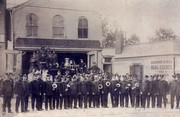

http://www.newtownhistorical.org/maspeth-history/the-legacy-of-herman-ringe
56-07 Metropolitan Avenue:

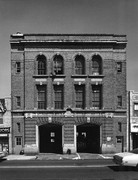
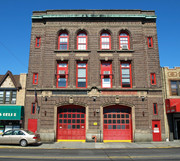
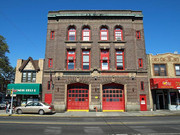
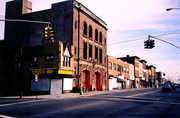


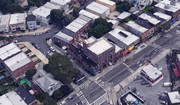
Engine 291:





Ladder 140:
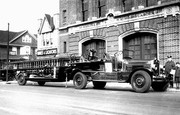
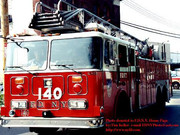
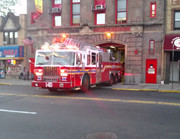
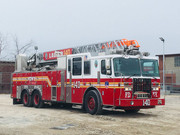

Engine 291/Ladder 140:
https://www.youtube.com/watch?v=jeob2gbvGGg
https://www.youtube.com/watch?v=TJtmMCikarc
Engine 291/Ladder 140 Centennial:
http://www.ny1.com/nyc/queens/news/2015/09/29/ridgewood-fire-house-celebrates-100-years-of-service.html
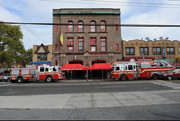
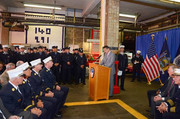
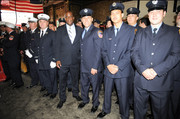

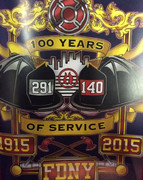
Engine 291 LODD:
LIEUTENANT JOHN MAYER ENGINE 291 May 24, 1929
Lieutenant John Mayer suffered a fractured skull when he plunged down a flight of stairs in the quarters of Engine 291. He died the following morning at his home. A physician was summoned to his home when he failed to respond to calls. When he fell down the stairs in the engine house, other members of Engine 291 found him unconscious. He regained consciousness quickly and said he received no injuries. He went home and was found dead in his bed the next morning.
RIP. Never forget.
FF Albert E. Guinness Ladder 140 - Founder FDNY Uniformed Firemen's Association:
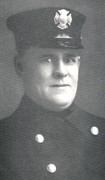
Albert E. Guinness is the epitome of the expression, "one man can make a difference." Born in 1875 and joining the FDNY in September 1905, Guinness was the driving force behind the formation of the Uniformed Firemen's Association and its affiliation with the powerful American Federation of Labor. And while lauded by the rank and file, he was not only vilified, he was targeted by the administration.
Guinness was a firefighter in Ladder Company 140 near his home in Long Island City. In 1918, one year after establishment of the UFA, he was given an un-requested transfer to Ladder 24 in Manhattan in retaliation ? according to newspaper reports ? for leading firefighters in the Labor Day Parade on Fifth Avenue. In 1922 he was again transferred, this time to Engine Company 70 on City Island, virtually an impossible three-hour commute for someone then living in Brooklyn. This later transfer occurred after his lobbying for back pay due to veterans of the First World War as required under legislation passed the previous year. Three years later he received a transfer to Engine Company 235 that finally brought him closer to his home.
Some of his accomplishments to improve the lives of his brother firefighters included a twenty-seven percent salary increase in 1920 bringing annual pay up to $1,900 per year. In 1922 the two-platoon system was initiated bringing working hours down from 151 per week to 84. One of Guinness' major goals was to bring about legislative action making death of a firefighter from heart disease a job-related event. That finally happened in 1969.
Not long after his retirement the same year, Albert E. Guinness died on March 12, 1927 from appendicitis at Methodist Hospital in Brooklyn. He is interred in an unmarked grave Greenwood Cemetery. Annual memorial services were held for him by the UFA for many years after his death. A window to the memory of Albert Guinness was donated by the UFA at the Central Methodist Church in Flatbush, Brooklyn.
The UFA (now the Uniformed Firefighters Association) continues to represent the uniformed force as its bargaining unit.
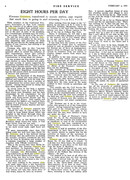
- "Fire Protection Service" Volume 83 1925
Ridgewood History:
https://ny.curbed.com/2016/5/24/11755562/how-bushwick-and-ridgewood-once-entwined-became-distinct-neighborhoods
http://forgotten-ny.com/2005/07/ridgewood-queens/

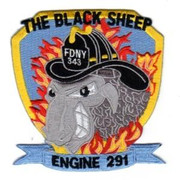


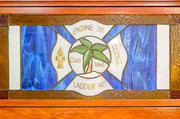
Engine 291 organized 56-07 Metropolitan Avenue w/Ladder 140 1915
Ladder 140 organized 56-07 Metropolitan Avenue w/Engine 291 1915
Pre-FDNY:
Ridgewood was protected by Metropolitan Engine Company 12 located on Metropolitan Avenue. Engine 12 was part of the Newtown Fire Department.


http://www.newtownhistorical.org/maspeth-history/the-legacy-of-herman-ringe
56-07 Metropolitan Avenue:








Engine 291:





Ladder 140:





Engine 291/Ladder 140:
https://www.youtube.com/watch?v=jeob2gbvGGg
https://www.youtube.com/watch?v=TJtmMCikarc
Engine 291/Ladder 140 Centennial:
http://www.ny1.com/nyc/queens/news/2015/09/29/ridgewood-fire-house-celebrates-100-years-of-service.html





Engine 291 LODD:
LIEUTENANT JOHN MAYER ENGINE 291 May 24, 1929
Lieutenant John Mayer suffered a fractured skull when he plunged down a flight of stairs in the quarters of Engine 291. He died the following morning at his home. A physician was summoned to his home when he failed to respond to calls. When he fell down the stairs in the engine house, other members of Engine 291 found him unconscious. He regained consciousness quickly and said he received no injuries. He went home and was found dead in his bed the next morning.
RIP. Never forget.
FF Albert E. Guinness Ladder 140 - Founder FDNY Uniformed Firemen's Association:

Albert E. Guinness is the epitome of the expression, "one man can make a difference." Born in 1875 and joining the FDNY in September 1905, Guinness was the driving force behind the formation of the Uniformed Firemen's Association and its affiliation with the powerful American Federation of Labor. And while lauded by the rank and file, he was not only vilified, he was targeted by the administration.
Guinness was a firefighter in Ladder Company 140 near his home in Long Island City. In 1918, one year after establishment of the UFA, he was given an un-requested transfer to Ladder 24 in Manhattan in retaliation ? according to newspaper reports ? for leading firefighters in the Labor Day Parade on Fifth Avenue. In 1922 he was again transferred, this time to Engine Company 70 on City Island, virtually an impossible three-hour commute for someone then living in Brooklyn. This later transfer occurred after his lobbying for back pay due to veterans of the First World War as required under legislation passed the previous year. Three years later he received a transfer to Engine Company 235 that finally brought him closer to his home.
Some of his accomplishments to improve the lives of his brother firefighters included a twenty-seven percent salary increase in 1920 bringing annual pay up to $1,900 per year. In 1922 the two-platoon system was initiated bringing working hours down from 151 per week to 84. One of Guinness' major goals was to bring about legislative action making death of a firefighter from heart disease a job-related event. That finally happened in 1969.
Not long after his retirement the same year, Albert E. Guinness died on March 12, 1927 from appendicitis at Methodist Hospital in Brooklyn. He is interred in an unmarked grave Greenwood Cemetery. Annual memorial services were held for him by the UFA for many years after his death. A window to the memory of Albert Guinness was donated by the UFA at the Central Methodist Church in Flatbush, Brooklyn.
The UFA (now the Uniformed Firefighters Association) continues to represent the uniformed force as its bargaining unit.

- "Fire Protection Service" Volume 83 1925
Ridgewood History:
https://ny.curbed.com/2016/5/24/11755562/how-bushwick-and-ridgewood-once-entwined-became-distinct-neighborhoods
http://forgotten-ny.com/2005/07/ridgewood-queens/





Engine 25 firehouse 342 E 5th Street East Village, Manhattan DISBANDED
Engine 25 organized 342 E 5th Street former volunteer firehouse 1865
Engine 25 disbanded 1947
Ladder 11 located at 342 E 5th Street at Engine 25 1883
Pre-FDNY:
Jefferson Engine 26 organized 1803
Jefferson Engine 26 moved Henry & Rutgers Streets 1813
Jefferson Engine 26 moved Madison & Rutgers Streets 1832
Jefferson Engine 26 moved Rutgers Street 1836
Jefferson Engine 26 moved 205 Madison Street 1836
Jefferson Engine 26 moved 6 3rd Street 1851
Jefferson Engine 26 new firehouse 342 E 5th Street 1852
Jefferson Engine 26:

Engine 25 Metropolitan Fire Department 1865:
Metropolitan Steam Engine Company No. 25, (with horses) -- JOHN ALLEN, foreman, No. 342 East Fifth-street.
Note - Foreman (Captain) pay $800 per year; Asst Foreman (Lieutenant) pay $750 per year; firemen pay $700 per year
Engine 25 FDNY:

Engine 25 Roll of Merit:
Foreman Peter Weir, on August 17, 1871, went through smoke and flames to the 6th floor at 15 Forsyth Street, to rescue a woman and child.

Engine 25 disbanded January 1, 1947:
On the evening of December 31, 1946, Engine 25 was 3rd due at a multiple alarm fire, Box 396, in a 7 story, 25x100, non-fire proof loft building at 749 Broadway. All Engine 25 members narrowly escaped a collapse which took the lives of two firefighters, BC William Hogan Battalion 5 and FF Winfield Walsh Ladder 9. Engine 25 continued to work at the multiple alarm after midnight when the company had been disbanded.
Volunteer history:
Our Firemen, The History of the NY Fire Departments
Chapter 35, Part I
No. 26. - -Jefferson.--("Blue Boys"). -- The company was organized in 1803. The first record of its location is when she lay in Henry Street near the Presbyterian Church, in Rutgers Street in 1813. During the year 1832 No. 26 moved to Madison Street, near Rutgers, in a frame building on the side of the brick building afterwards used by the company, and after 1845 by Oceana Hose Company No. 36. When the brick house at 205 Madison Street was finished, the company commenced to run the Blue Box Engine, calling themselves the "Blue Boys," with the rallying cry of "True Blue Never Fades." This engine was one of the handsomest, and at the same time the best geared, the lightest running and fastest engine of its day. Joseph Perkins, Elijah King (who afterwards kept the St. mark's Place Hotel, and, later on, the Fire island House) and Ethan L. Blanck were the foremen in those days, and in their little disputes with the "skivers" crowd (No. 39 Engine Company) Dave Phillips, and Jim or Puss Adams, were among the foremost in delivering striking arguments to their opponents. Jamieson Cox, chief engineer of the Department in 1824-28, was appointed an assistant engineer from this company. At the time of the Lorillard fire in Chatham Street, about where Leggett's Hotel now stands, Cox, then a member of 26 Engine, was on a three story ladder that was resting on the front of the building having 26's pipe. Some of the members noticed that the wall was shaking and called to Cox to come down. He had himself recognized the danger of his situation, and by a sudden and powerful effort jumped the ladder from the front of the building over to the front of the next on just as the wall fell in with a crash. Had he not moved the ladder over as he did, nothing could have saved him.
About May, 1836, the men were having some repairs done to their house in Madison Street, and ran from a little wooden shanty on the north side of Rutgers Street, one door from Madison Street. While in this temporary location the building was discovered to be on fire one day, and on Mr. Charles J. Harris, one of the members, and Thomas Coger, a volunteer, arriving at the house and opening the doors, they were unable to draw the engine from the house, the machine having either been fastened to the floor, or the wheels so chocked that the engine could not be moved. The engine, which was a very handsome one with polished iron work, and a great deal of elaborate carving on it, was partially destroyed. It was a comparatively new machine, having been in use but about three years. this did not prevent the company from continuing their fire duty. They immediately applied for and obtained the engine that had been turned in by Hudson Engine Company No. 1, and commenced to run from their house in Madison Street.
At the fire in the Tribune building which occurred February 5, 1845, during a heavy snow storm which had lasted twenty-four hours, the streets being impassable for their engine, the members of 26 Engine Company put their hose on a wood sled belonging to Hecker, the flour merchant, and drew it to the fire, Zophar Mills and Charles Forrester being on the rope going down. The members then went and helped Engine Company No. 23 across the City Hall Park, they not having yet reached the fire from Anthony Street.
On the occasion of the obsequies of ex-President Andrew Jackson in New York, June 24, 1845, a great many of the New York fire companies turned out without their apparatus, and among others were Engine Companies Nos. 2 and 26. They had just reached the City Hall, where they were to be dismissed, then the Hall bell struck for the fifth district. Both companies started after their engines, and on reaching Chatham Square No. 26 Engine could be seen coming down East Broadway, and No. 2 Engine coming down Division Street. After a little parley about "going out first," No. 2 engine started over toward Oliver Street, and John Harden, foreman of No. 26 Engine, headed his company over to Mott Street. This "skinned" No. 2 engine's rope, and the fun began. Both companies were halted at Chatham and Chambers Streets, where some lively hitting out was indulged in until stopped by Chief Anderson, and both companies sent home. They went back side by side, stopping a few moments before the Chatham Theater to exchange compliments, and as No. 2 engine men hooted at No. 26. As they separated at Chatham Square, they were obliged to continue hostilities in front of old Johnny Pease's candy store in Division Street, which ended in No. 2 engine being tied up to a lamp post, corner of Rutgers and Henry Streets.
On the night of July 16, 1845, there were several alarms struck and one of them was for the fire in the old Dispensary, corner of White and Centre Streets. On their way home, when in Walker Street near Eldridge Street, and about opposite the old Sawdust House, kept by "Yankee" Sullivan, No. 2 Engine ran into No. 26 Engine and they struck out right and left. The companies were ordered out run in "tongue first," and the next night their houses were locked up, neither company being present at the great fire which took place down town shortly afterwards. The Blue Engine which No. 26 ran was taken away, but is said to still be in existence. It had a plate on the back of it of Jefferson writing the Declaration of Independence. The company was disbanded on September 22, 1845. A company bearing the same number and name, organized on December 2, 1851, by the company formerly known as Hose Company No. 32, was stationed at No. 6 third Street, and later in Fifth Street near First Avenue. It went out of service in 1865.
Engine 25 organized 342 E 5th Street former volunteer firehouse 1865
Engine 25 disbanded 1947
Ladder 11 located at 342 E 5th Street at Engine 25 1883
Pre-FDNY:
Jefferson Engine 26 organized 1803
Jefferson Engine 26 moved Henry & Rutgers Streets 1813
Jefferson Engine 26 moved Madison & Rutgers Streets 1832
Jefferson Engine 26 moved Rutgers Street 1836
Jefferson Engine 26 moved 205 Madison Street 1836
Jefferson Engine 26 moved 6 3rd Street 1851
Jefferson Engine 26 new firehouse 342 E 5th Street 1852
Jefferson Engine 26:

Engine 25 Metropolitan Fire Department 1865:
Metropolitan Steam Engine Company No. 25, (with horses) -- JOHN ALLEN, foreman, No. 342 East Fifth-street.
Note - Foreman (Captain) pay $800 per year; Asst Foreman (Lieutenant) pay $750 per year; firemen pay $700 per year
Engine 25 FDNY:

Engine 25 Roll of Merit:
Foreman Peter Weir, on August 17, 1871, went through smoke and flames to the 6th floor at 15 Forsyth Street, to rescue a woman and child.

Engine 25 disbanded January 1, 1947:
On the evening of December 31, 1946, Engine 25 was 3rd due at a multiple alarm fire, Box 396, in a 7 story, 25x100, non-fire proof loft building at 749 Broadway. All Engine 25 members narrowly escaped a collapse which took the lives of two firefighters, BC William Hogan Battalion 5 and FF Winfield Walsh Ladder 9. Engine 25 continued to work at the multiple alarm after midnight when the company had been disbanded.
Volunteer history:
Our Firemen, The History of the NY Fire Departments
Chapter 35, Part I
No. 26. - -Jefferson.--("Blue Boys"). -- The company was organized in 1803. The first record of its location is when she lay in Henry Street near the Presbyterian Church, in Rutgers Street in 1813. During the year 1832 No. 26 moved to Madison Street, near Rutgers, in a frame building on the side of the brick building afterwards used by the company, and after 1845 by Oceana Hose Company No. 36. When the brick house at 205 Madison Street was finished, the company commenced to run the Blue Box Engine, calling themselves the "Blue Boys," with the rallying cry of "True Blue Never Fades." This engine was one of the handsomest, and at the same time the best geared, the lightest running and fastest engine of its day. Joseph Perkins, Elijah King (who afterwards kept the St. mark's Place Hotel, and, later on, the Fire island House) and Ethan L. Blanck were the foremen in those days, and in their little disputes with the "skivers" crowd (No. 39 Engine Company) Dave Phillips, and Jim or Puss Adams, were among the foremost in delivering striking arguments to their opponents. Jamieson Cox, chief engineer of the Department in 1824-28, was appointed an assistant engineer from this company. At the time of the Lorillard fire in Chatham Street, about where Leggett's Hotel now stands, Cox, then a member of 26 Engine, was on a three story ladder that was resting on the front of the building having 26's pipe. Some of the members noticed that the wall was shaking and called to Cox to come down. He had himself recognized the danger of his situation, and by a sudden and powerful effort jumped the ladder from the front of the building over to the front of the next on just as the wall fell in with a crash. Had he not moved the ladder over as he did, nothing could have saved him.
About May, 1836, the men were having some repairs done to their house in Madison Street, and ran from a little wooden shanty on the north side of Rutgers Street, one door from Madison Street. While in this temporary location the building was discovered to be on fire one day, and on Mr. Charles J. Harris, one of the members, and Thomas Coger, a volunteer, arriving at the house and opening the doors, they were unable to draw the engine from the house, the machine having either been fastened to the floor, or the wheels so chocked that the engine could not be moved. The engine, which was a very handsome one with polished iron work, and a great deal of elaborate carving on it, was partially destroyed. It was a comparatively new machine, having been in use but about three years. this did not prevent the company from continuing their fire duty. They immediately applied for and obtained the engine that had been turned in by Hudson Engine Company No. 1, and commenced to run from their house in Madison Street.
At the fire in the Tribune building which occurred February 5, 1845, during a heavy snow storm which had lasted twenty-four hours, the streets being impassable for their engine, the members of 26 Engine Company put their hose on a wood sled belonging to Hecker, the flour merchant, and drew it to the fire, Zophar Mills and Charles Forrester being on the rope going down. The members then went and helped Engine Company No. 23 across the City Hall Park, they not having yet reached the fire from Anthony Street.
On the occasion of the obsequies of ex-President Andrew Jackson in New York, June 24, 1845, a great many of the New York fire companies turned out without their apparatus, and among others were Engine Companies Nos. 2 and 26. They had just reached the City Hall, where they were to be dismissed, then the Hall bell struck for the fifth district. Both companies started after their engines, and on reaching Chatham Square No. 26 Engine could be seen coming down East Broadway, and No. 2 Engine coming down Division Street. After a little parley about "going out first," No. 2 engine started over toward Oliver Street, and John Harden, foreman of No. 26 Engine, headed his company over to Mott Street. This "skinned" No. 2 engine's rope, and the fun began. Both companies were halted at Chatham and Chambers Streets, where some lively hitting out was indulged in until stopped by Chief Anderson, and both companies sent home. They went back side by side, stopping a few moments before the Chatham Theater to exchange compliments, and as No. 2 engine men hooted at No. 26. As they separated at Chatham Square, they were obliged to continue hostilities in front of old Johnny Pease's candy store in Division Street, which ended in No. 2 engine being tied up to a lamp post, corner of Rutgers and Henry Streets.
On the night of July 16, 1845, there were several alarms struck and one of them was for the fire in the old Dispensary, corner of White and Centre Streets. On their way home, when in Walker Street near Eldridge Street, and about opposite the old Sawdust House, kept by "Yankee" Sullivan, No. 2 Engine ran into No. 26 Engine and they struck out right and left. The companies were ordered out run in "tongue first," and the next night their houses were locked up, neither company being present at the great fire which took place down town shortly afterwards. The Blue Engine which No. 26 ran was taken away, but is said to still be in existence. It had a plate on the back of it of Jefferson writing the Declaration of Independence. The company was disbanded on September 22, 1845. A company bearing the same number and name, organized on December 2, 1851, by the company formerly known as Hose Company No. 32, was stationed at No. 6 third Street, and later in Fifth Street near First Avenue. It went out of service in 1865.
Mack,
You're an absolute wonder!
Hope you don't mind a suggestion, but keep an eye out so these gems won't be lost to the "ethernet" like "Section 1" was.
History as recorded by you, guitarman314, memorymaster and so many other site members (down to the up-to-the-minute box alarm assignments from so many dedicated people) is absolutely critical not only for FDNY but for the City itself, for future generations of Firefighters, schoolchildren, doctoral candidates, potential recruits and historians. Do you think there is there any way the Fire Museum or some other FDNY or City component might want to archive your work? In fact, might the Museum, FDNY, WNYF or City be interested in archiving the extraordinary history, training hints and other issues presented on NYCFIRE.NET? And would our members from Eire, the UK and other EU nations, South America (and Uncle Willy's northern suburbs, of course) and other areas be interested in formally inviting aboard their Professional and Volunteer Departments?
These things are much too important to be left to hope. There's too much precious history on this site to be left to luck.
Thanks for all your extraordinary work.
You're an absolute wonder!
Hope you don't mind a suggestion, but keep an eye out so these gems won't be lost to the "ethernet" like "Section 1" was.
History as recorded by you, guitarman314, memorymaster and so many other site members (down to the up-to-the-minute box alarm assignments from so many dedicated people) is absolutely critical not only for FDNY but for the City itself, for future generations of Firefighters, schoolchildren, doctoral candidates, potential recruits and historians. Do you think there is there any way the Fire Museum or some other FDNY or City component might want to archive your work? In fact, might the Museum, FDNY, WNYF or City be interested in archiving the extraordinary history, training hints and other issues presented on NYCFIRE.NET? And would our members from Eire, the UK and other EU nations, South America (and Uncle Willy's northern suburbs, of course) and other areas be interested in formally inviting aboard their Professional and Volunteer Departments?
These things are much too important to be left to hope. There's too much precious history on this site to be left to luck.
Thanks for all your extraordinary work.
- Joined
- May 6, 2010
- Messages
- 17,483
You do not need to be embarrassed about anything on here ...you do more behind the scenes than most know especially for Veterans....Thank YOU !manhattan said:Sorry, Chief,
I'm embarassed - I should have mentioned you, Bill D. and numerous other members as Most Valuable Contributors.
Please forgive the oversight.
Engine 203 - 1912 Mack high pressure hose wagon:
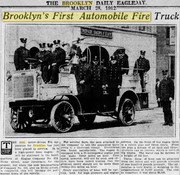
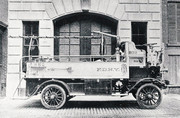
High pressure engine companies were established in Manhattan and Brooklyn to use the new high pressure water pumping systems. The plan was to take lines off high pressure hydrants without the use of steamers. High pressure companies initially were viewed as successful holding greater alarms at lower alarm assignments and eliminating the requirement of multiple section engine companies. The limitations, however, were that high pressure companies without steamers could not respond outside their limited high pressure pumping system response area and relocations into high pressure areas was also limited. High pressure engine companies were phased out but the high pressure pumping systems remained in operation in parts of Manhattan and Brooklyn into the 1970s.


High pressure engine companies were established in Manhattan and Brooklyn to use the new high pressure water pumping systems. The plan was to take lines off high pressure hydrants without the use of steamers. High pressure companies initially were viewed as successful holding greater alarms at lower alarm assignments and eliminating the requirement of multiple section engine companies. The limitations, however, were that high pressure companies without steamers could not respond outside their limited high pressure pumping system response area and relocations into high pressure areas was also limited. High pressure engine companies were phased out but the high pressure pumping systems remained in operation in parts of Manhattan and Brooklyn into the 1970s.


